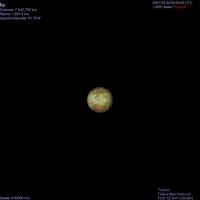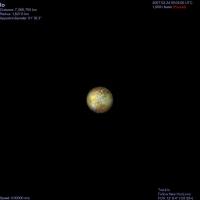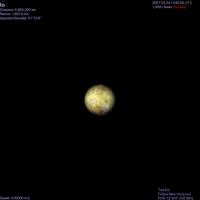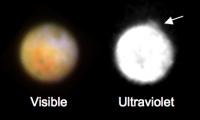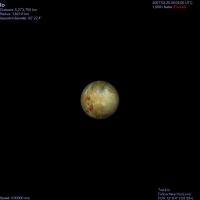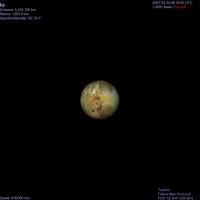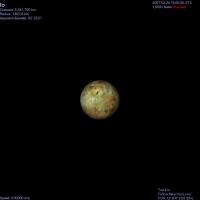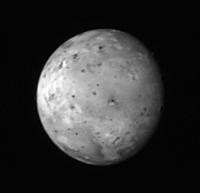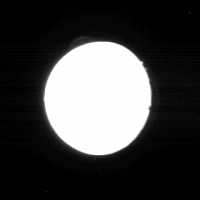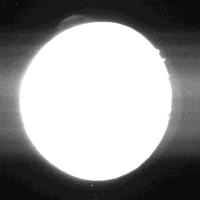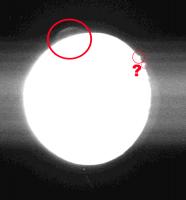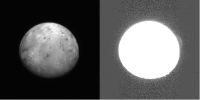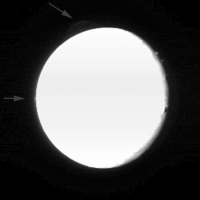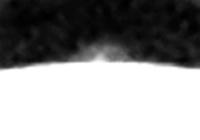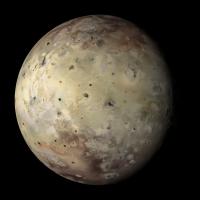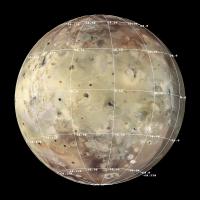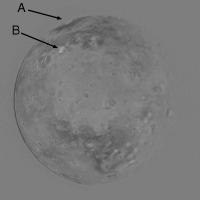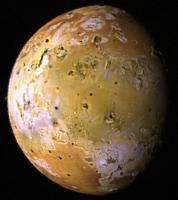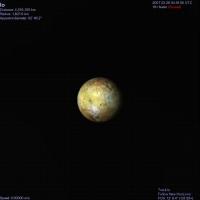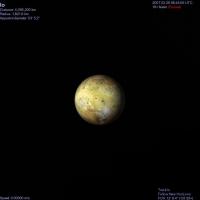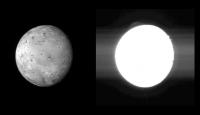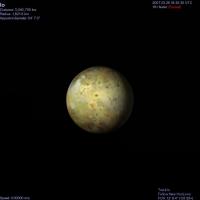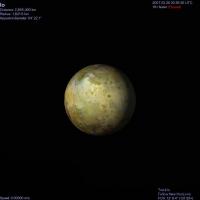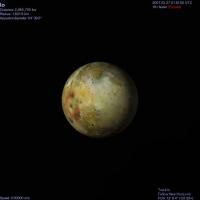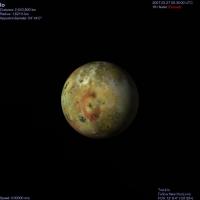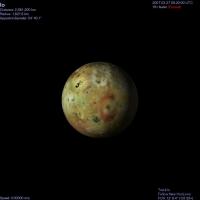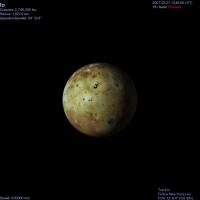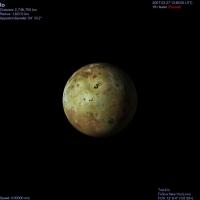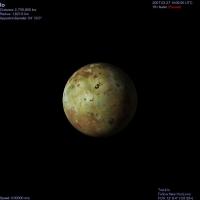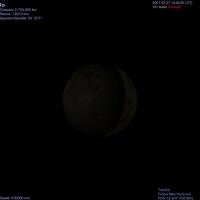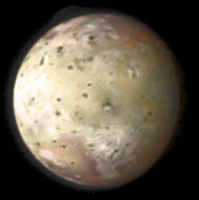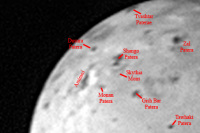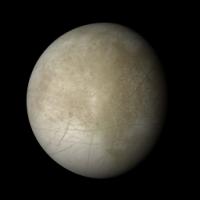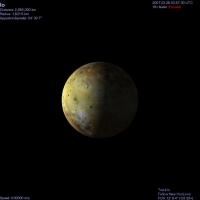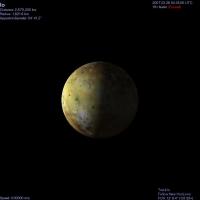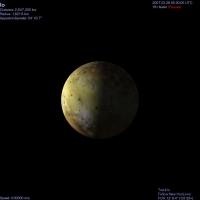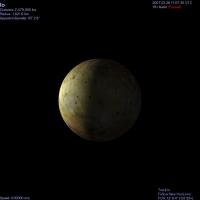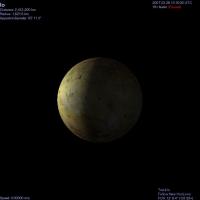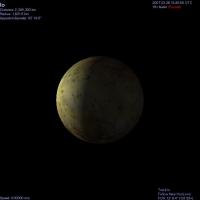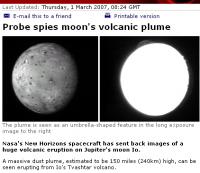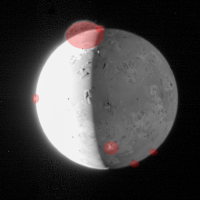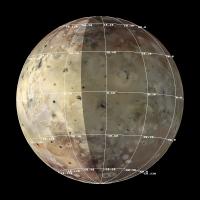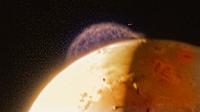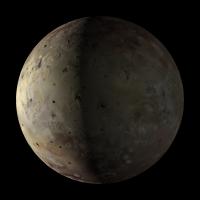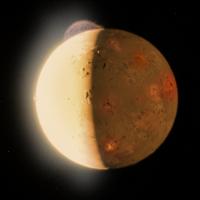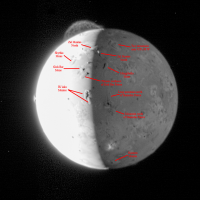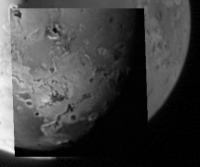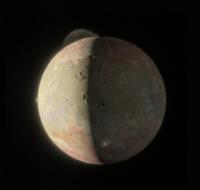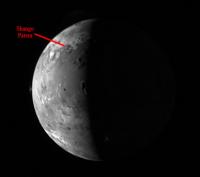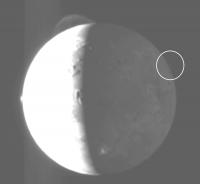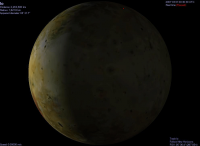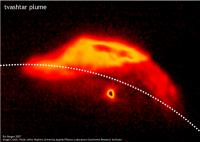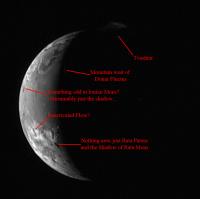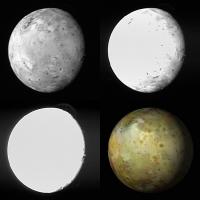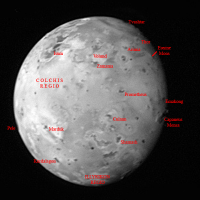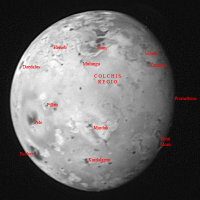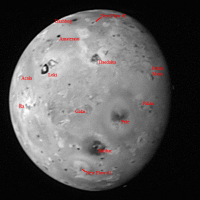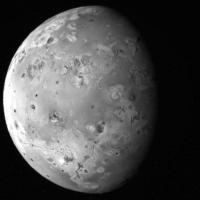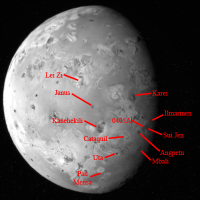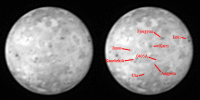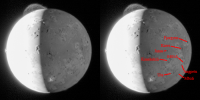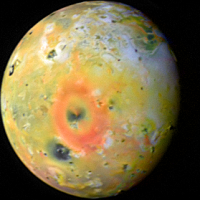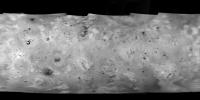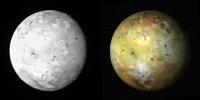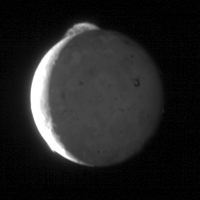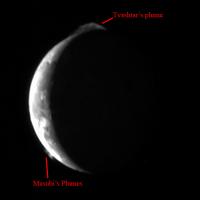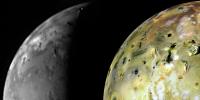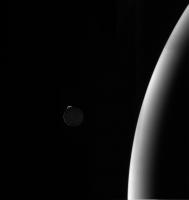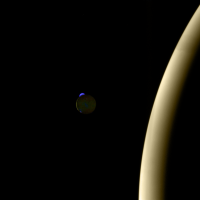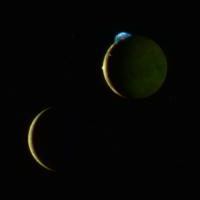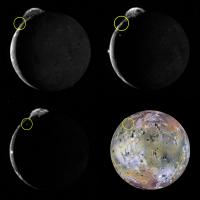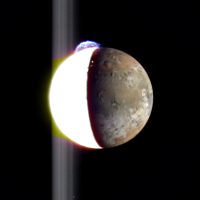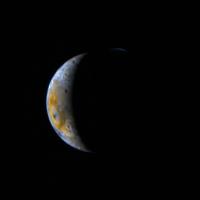Printable Version of Topic
Click here to view this topic in its original format
Unmanned Spaceflight.com _ New Horizons _ New Horizons at Io
Posted by: volcanopele Feb 24 2007, 07:53 PM
Since the New Horizons Jupiter Encounter thread is already getting pretty long, I decided to create a thread dedicated to New Horizons' observations of the most interesting object in the solar system: Io. Info on upcoming observations comes from the jupiter_timeline_static.xls document john_s posted, and the preview images are from Celestia (note that each image is scaled so that the pixel scale is ~correct, and represents a smaller FOV than LORRI)
Today, February 24, New Horizons conducts three observations of Io with the LORRI camera as well some observations of Io's atmosphere with ALICE. These observations have the lowest phase angle for Io of the entire encounter. Phase angle continues to increase as NH approaches Jupiter and Io.
The first observation, ISunMon1, shows Io's sub-Jovian hemisphere (Clat=5.5 S, Clon=340.2 W) from a distance of 7,856,307 km. The resolution with LORRI would be 38.8 km/pixel. Pele is on the limb at lower right and Masubi is on the limb at lower left. Ra Patera is near center.
The second observation, ISunMon2, also shows Io's sub-Jovian hemisphere (Clat=5.5 S, Clon=15.1 W) from a distance of 7,575,510 km. The resolution with LORRI would be 37.5 km/pixel. The Tvashtar plume might be poking above the limb at upper left.
The third observation, ISunMon3, shows Io's leading hemisphere (Clat=6.0 S, Clon=84.7 W) from a distance of 6,627,459 km. The resolution with LORRI would be 32.8 km/pixel. The Zamama plume might be visible just above center on the left limb.
It only gets better from here. Not sure how NH downlink works, but there is a DSN window right after the last Io observation, hopefully at least one frame from each observation will be returned. Maybe they can do the Huffman window right around where Io is... Tomorrow contains four more observations of Io, highlighting Pele and an eclipse.
Posted by: elakdawalla Feb 24 2007, 08:02 PM
Jason, in case you didn't see it, here's the brand new image of Io from Hubble that http://planetary.org/blog/article/00000874/:
--Emily
Posted by: volcanopele Feb 24 2007, 08:28 PM
Cool, certainly looks like it could be Tvashtar. Given the viewing geometry, there is a slightly better candidate in an unnamed patera at 61N, 143 W, but given that it was only seen as a hot spot once, Tvashtar would be the better candidate.
Posted by: john_s Feb 24 2007, 09:40 PM
More Hubble images now down- the Tvashtar(?) plume continues to be active through at least February 22nd, so there's a good chance that it will be active during the flyby too. Hubble only sees the plume in the ultraviolet, so it's not a sure thing that we'll see it at longer wavelengths with New Horizons, but I think the chances are quite good, particularly after closest approach when high phase angles will make it more visible.
Posted by: volcanopele Feb 24 2007, 09:46 PM
That's a good point. Given the phase angles of these early images, it maybe rather difficult to resolve most of the plumes on Io.
Posted by: john_s Feb 24 2007, 10:58 PM
The only Io images we'll get down before the second week of March are ISunMon09, taken at 8:40 on 2/26, which will be sent down during the downlink immediately following on the 26th, and IHiRes05, taken at 11:00 on 2/28, which will come down during the downlink starting at 15:52 on 2/28. The limitation is as much the time needed to compress the images and prepare them for downlink, given how busy the spacecraft is, as the actual transmission time. Both will show the same hemisphere of Io, centered on longitude ~65, with Prometheus on the limb and Tvashtar also near the limb. I goofed slightly in selecting these two as our early downlink images, given their similar geometry, but there *were* a lot of constraints.
John.
Posted by: volcanopele Feb 25 2007, 06:52 PM
Today, February 25, New Horizons conducts three monitoring observations of Io with the LORRI camera focusing on the trailing hemisphere, as well some observations of Io's atmosphere with ALICE and an observation of Io while it is in eclipse with the LORRI, ALICE, and RALPH instruments. As noted in the post above, these observations won't be returned until next month.
Please keep in mind that these are simulations of the LORRI frames from Celestia, not the LORRI frames themselves...
The first observation, ISunMon5, shows Io's trailing hemisphere (Clat=3.0 S, Clon=225.4 W) from a distance of 5,276,976 km. The resolution with LORRI would be 26.1 km/pixel. Pele is visible at lower left and Prometheus is at center right. If Loki's plume(s) are active, then it *might* be visible at upper left.
The second observation, ISunMon6, shows Io's trailing hemisphere (Clat=3.0 S, Clon=253.1 W) from a distance of 5,217,587 km. The resolution with LORRI would be 25.8 km/pixel. Pele is now just below center and Loki has rotated into view at upper left. Prometheus' plume might be visible at center right, though as noted in the above posts, this might not be the best viewing geometry for observing Io's plumes given LORRI's wavelength range.
The third observation, ISunMon7, shows Io's trailing hemisphere (Clat=3.0 S, Clon=308.1 W) from a distance of 5,184,145 km. The resolution with LORRI would be 25.6 km/pixel. Pele is now visible at lower right. Loki is now visible near center. Not sure where Loki is in its geological clock, but the SNR of LORRI might be enough to allow one to see where the overturn front is in Loki Patera.
The final observation is Ieclipse1, an observation of Io in eclipse. RALPH will be active during the eclipse, allowing for an observation of Io's current volcanic activity. Loki should be easily visible in the LEISA images, depending again on where it is in its geological clock...
Posted by: just-nick Feb 25 2007, 07:09 PM
John.
Thanks for the inside look at the downlink. As always, the NH team is making us feel like real insiders.
What's the likely turnaround for these images to make it onto the SOC page? I remember things like the MER landings and Deep Impact where the first download images were just popping in right there on NASA TV but also situations like Huygens where there was a lot of stitching and sifting.
And what can we expect from the downlink that just happened?
Incidentally, what sort of compression are you using?
Posted by: ugordan Feb 27 2007, 05:48 PM
Woohoo, 2 new Io images!
And an eruption! Is that Jupitershine illuminating Io's night side or an internal reflection?
Posted by: john_s Feb 27 2007, 05:55 PM
A little experiment on you guys- we posted the images about 40 minutes ago and were wondering how long it would take someone to notice them and spot the plume! We'll be doing a proper press release image in a few hours.
John.
Posted by: Alan Stern Feb 27 2007, 05:58 PM
John seems to have a little too much time on his hands, wouldn't you say, gents?
Posted by: ugordan Feb 27 2007, 06:00 PM
Yeah, he'd better get that press release done before us guys scoop you! ![]()
Posted by: Exploitcorporations Feb 27 2007, 06:03 PM
Damn. Looks like two of them. Didn't notice Tvashtar popping off too!
Edit...oopsie. My monitor washed out ugordon's pic. This is awesome.
Posted by: ugordan Feb 27 2007, 06:06 PM
Umm, where do you see the second plume?
Posted by: siravan Feb 27 2007, 06:07 PM
Hi eveyone. This is my first post to UMSF. Here is my take on "plume finding" on Io.
Posted by: Exploitcorporations Feb 27 2007, 06:07 PM
I thought I saw one on the center limb. Didn't realize that the Tvashtar plume was clearly visible in your pic.
Posted by: john_s Feb 27 2007, 06:11 PM
Good eyes, exploitcorporations! There is a very small plume on the center limb (around 9 o'clock)- that's Prometheus.
John.
Posted by: Bjorn Jonsson Feb 27 2007, 06:14 PM
That's spectacular and one can even easily discern the plume's umbrella-like shape. This is not a surprise because with extreme contrast enhancement plumes are visible in some of the low-phase Voyager 1 clear filter images of Io (for example C1636826.IMQ) despite Voyager 1's more primitive camera.
Makes me wonder what the Voyager 1 Jupiter encounter would have been like had the Internet and powerful computers been common back then and if the image release policy was MER/Cassini/NH-like. One thing is certain: The plumes would have been discovered *before* the Io flyby.
Posted by: JRehling Feb 27 2007, 06:14 PM
John.
I see the small one at 9 o'clock, the large hazy one at 11 o'clock, and two small features around 2 o'clock which are either big mountains peeking over the limb or smaller forelit plumes.
Posted by: Exploitcorporations Feb 27 2007, 06:16 PM
Are those a couple on the terminator, too?
edit...sorry, I keep getting out of sequence. kabooom.
Posted by: john_s Feb 27 2007, 06:17 PM
Nope, those are mountains on the terminator
Posted by: Bjorn Jonsson Feb 27 2007, 06:19 PM
Knowing the viewing and lighting geometry or the *exact* time the image was obtained would be lovely - then I could make a hi-res computer rendering to check what these features near the terminator are...
EDIT: Didn't see John's reply (these are mountains) before I wrote this.
Posted by: volcanopele Feb 27 2007, 06:24 PM
Note the double ring around Masubi!
GREAT IMAGES, john_s!!!! This is such a good day, for other spacecraft images as well...
Posted by: DEChengst Feb 27 2007, 06:25 PM
Great pics, thanks for putting them up so quickly. Hoping for more the coming days ![]()
Quick question for John about the lecture you'll be giving tomorrow:
Will it be recorded and put on the web ?
Posted by: Exploitcorporations Feb 27 2007, 06:27 PM
Those mountains look from the map like they might be part of the big complex to the east and northeast of Ukko Patera about 10W 40N.
Posted by: ugordan Feb 27 2007, 06:29 PM
Great catch on the 9 c'clock plume, Exploitcorporations! I wrote it off as scattered light/topography, but a little sharpening brings out the nebulosity of the feature nicely.
Bjorn, we already know the time when the image was taken: 2007-02-26 08:40:04 UTC
Posted by: remcook Feb 27 2007, 06:33 PM
sorry, but I have to add another wow! happy days ![]()
Posted by: john_s Feb 27 2007, 06:38 PM
Will it be recorded and put on the web ?
Apparently slooh.com will be trying to do something to broadcast it- they have a 7-day free trial membership.
And siravan's image was interesting, showing the plume in the short-exposure image- I hadn't noticed it in that frame, having concentrated on the long exposure frame. And ugordan's view of Prometheus is better than anything I'd come up with so far. Nice stuff!
John.
Posted by: Exploitcorporations Feb 27 2007, 06:46 PM
Looks like Prometheus shows up okay in the short exposure too, waaaay stretched:
Posted by: DEChengst Feb 27 2007, 06:55 PM
Too bad that doesn't look like a very good option. For the trial you need to get yourself the most expensive account and cancel within a week. That's something I don't really like, and wouldn't be an option for me anyway, as I don't have a creditcard.
If there's a way you could get me a videoclip of the lecture I'll put up a torrent to share it, and archive it on my webserver later. If that fails I also would be happy with just a sound recording and the slides of the lecture, so I can make a flash movie out off it to share with the world
Posted by: Bjorn Jonsson Feb 27 2007, 07:02 PM
I was too excited to notice
Here is a shaded computer rendering showing the area visible in NH's photo in detail:
And a diagram-like one:
There's something that looks like mountains like the terminator as had been indicated by John.
Posted by: volcanopele Feb 27 2007, 07:21 PM
Sorry I have been slacking off on the image previews. I've been sick the last couple of days and today has been extremely hectic at work!
I'll try to get the last two days work up tonight. Nice work everyone on these images that showed up this morning. I've only had a short amount of time to look at them unfortunately.
Posted by: lyford Feb 27 2007, 08:00 PM
clink clink clink clink
Posted by: SFJCody Feb 27 2007, 08:12 PM
Here is a shaded computer rendering showing the area visible in NH's photo in detail:
Someone should subtract this image from the New Horizons image in photoshop to spot the biggest surface changes.
Posted by: hendric Feb 27 2007, 08:24 PM
Wahoo! Great images everyone. You could have a NH pic of the day for the next few months as the rest of them stream down! ![]()
Posted by: Phil Stooke Feb 27 2007, 08:28 PM
"Someone should subtract this image from the New Horizons image in photoshop to spot the biggest surface changes."
What, like this?
It's a good idea, but Io looks so different in different fliters that it's no use unless the filter matches exactly. However, this is a first look at the question.
A is the big plume deposit - that does look different between old and new images. B is a smaller but real change. There are lots of smaller changes, but they get messed up by the filter issues. Wait for the real data - then it will be possible to do something.
Phil
Posted by: stevesliva Feb 27 2007, 08:36 PM
I'm wondering if the big new streak pointing southwest in the lower right quadrant of the new photo is new, or if it just doesn't show up in the low-res chunk of the composite image that happens to be there.
Posted by: volcanopele Feb 27 2007, 08:39 PM
Interesting ratio, Phil. Looks like something big happened at Shango Patera
Posted by: 4th rock from the sun Feb 27 2007, 09:15 PM
Here's a processed image from both exposures, with color data from the rendered view. Hope this helps in identifying changes. At least is a nice new Io image!
http://img45.imageshack.us/my.php?image=io2gw7.jpg
Some changes are visible :-)
Posted by: volcanopele Feb 27 2007, 09:28 PM
The map that Bjorn presents includes some Voyager data as well, so some of the changes seen between NH and this simulated view may actually be changes that occured between Galileo and Voyager. Check out this view from Galileo:
Posted by: AlexBlackwell Feb 27 2007, 09:33 PM
http://pluto.jhuapl.edu/gallery/missionPhotos/pages/022707_1.html is the aforementioned press release.
Posted by: ugordan Feb 27 2007, 09:38 PM
While trying to match Bjorn's rendered view to the LORRI image, I notice the right hand side (near the terminator) features are way off while the left hand side fits perfectly. It's as though at a single longitude someone ripped off the texture and misplaced it?
http://m1.freeshare.us/view/?128fs3457633.gif
Posted by: volcanopele Feb 27 2007, 10:05 PM
Yesterday, February 26, New Horizons conducts one monitoring observation with the LORRI camera focusing on the leading hemisphere, two "HiRes" observations with LORRI and RALPH instruments focusing on the leading and anti-Jovian hemisphere, as well some observations of Io's atmosphere with ALICE during a stellar occultation.
Please keep in mind that these are simulations of the LORRI frames from Celestia, not the LORRI frames themselves...with one exception
The first observation, Iocc1, is a stellar occultation of Io's atmosphere using the ALICE instrument. LORRI will also get a single frame shows Io's leading/pro-Jovian hemisphere (Clat=6.6 S, Clon=35.1 W) from a distance of 4,546,235 km. The resolution with LORRI would be 22.5 km/pixel. The Tvashtar plume should be at its fullest extent at upper left since Tvashtar is right on the limb.
The second observation, ISunMon9, shows Io's leading hemisphere (Clat=7.1 S, Clon=68.2 W) from a distance of 4,085,950 km. The resolution with LORRI would be 20.2 km/pixel. This observation is now on the ground so I don't think I need to discuss this much, but the Tvashtar and Prometheus plumes are visible along the bright limb, and volcanoes such as Lei Zi Fluctus and Masubi are highlighted.
The third observation, Ihiresir1, marks the start of high resolution observations at Io. The observation consists of both LORRI and RALPH frames (to look at Io in color and to examine the current distribution of hot spots). It will show Io's leading hemisphere (Clat=8.6 S, Clon=145.7 W) from a distance of 3,065,158 km. The resolution with LORRI would be 15.2 km/pixel. Prometheus is now front and center from this viewpoint. If Pillan is active, its plume might be visible at left.
The final observation, Ihires1, shows Io's anti-Jovian hemisphere Clat=8.6 S, Clon=145.7 W) from a distance of 2,880,909 km. The resolution with LORRI would be 14.2 km/pixel. The observation consists of both LORRI and RALPH frames (to look at Io in color and to examine the current distribution of hot spots). Prometheus has now rotated over to the right and Pele is now on the limb. *Maybe* its plume will be visible. The Tvashtar image above gives me hope.
Posted by: JRehling Feb 27 2007, 10:06 PM
"Io: Where the weather is also geology."
You can use that one.
Posted by: volcanopele Feb 27 2007, 10:10 PM
I know. I just wanted to bring that up because I am sure someone will mention the change around Kanehekili, which was something we saw with Galileo.
Posted by: volcanopele Feb 27 2007, 10:36 PM
Today, February 27, New Horizons conducts three, high-resolution mapping observations with LORRI and RALPH and an eclipse monitoring observation with LORRI, RALPH, and ALICE. The observations today focus on Io's anti-Jovian and trailing hemispheres.
Please keep in mind that these are simulations of the LORRI frames from Celestia, not the LORRI frames themselves...with one exception
The first observation, Ihires2, shows Io's anti-Jovian hemisphere Clat=9.1 S, Clon=203.0 W) from a distance of 2,691,322 km. The resolution with LORRI would be 13.3 km/pixel. The observation consists of both LORRI and RALPH frames (to look at Io in color and to examine the current distribution of hot spots). Pele has now rotated into view at lower left. The Prometheus plume should be visible at the terminator.
The second observation, Ihiresir2, shows Io's trailing hemisphere (Clat=8.9 S, Clon=238.2 W) from a distance of 2,645,200 km. The resolution with LORRI would be 13.1 km/pixel. Pele continues to be prominent in this observation, that includes compositional measurements from RALPH. How hot will Pele be in LEISA data? Will the Pele ring look different in MVIC data?
The third observation, Ihires3, will show Io's trailing hemisphere (Clat=8.4 S, Clon=267.2 W) from a distance of 2,679,220 km. The resolution with LORRI would be 13.3 km/pixel.
The final observation, Ieclipse3, shows Io's trailing hemisphere Clat=7.6 S, Clon=300.3 W) from a distance of 2,748,703 km. The resolution with LORRI would be 13.6 km/pixel.
Posted by: Bjorn Jonsson Feb 28 2007, 12:30 AM
Correct, I wanted the highest possible resolution rather than the most recent appearance so most of the Jupiter facing hemisphere is from Voyager data. IIRC Galileo was scheduled to image at least the right half of what's visible in the NH image at fairly high resolution (much higher than Voyager) very late in its mission but went into safe mode.
Hmm... a part of the right hand side was made from low-res Voyager data IIRC so there may be some positional inaccuracies but some of these differences seem to be due to surface changes between Voyager 1 and NH. I probably need to check my map - the Voyager USGS map I used as a reference when reverse engineering the viewing geometry of the Voyager images may also have been inaccurate (it was based on Voyager data only and also didn't make use of all of the useful Voyager images). No hi-res and useful map incorporating Galileo data was available to me back then but that situation has improved
Posted by: belleraphon1 Feb 28 2007, 12:44 AM
All I can say is WWW!!!!!!! (WOW WHATTA WEEK And thank goodness for the internet).
Io AND Titan ..... what a strange solar system we have met...... can't wait for the rest of New Horizon's data
............... cna't wait for Pluto/Charon...................
Craig
Posted by: Tom Tamlyn Feb 28 2007, 01:38 AM
I'm surprised that the reference images of Io are still from Voyager rather than Galileo. I realize that Galileo returned only a heartbreakingly small fraction of the high-resolution images of which it was capable, but I would have thought that it repeatedly covered Io at better than Voyager resolution.
I found this http://members.fortunecity.com/volcanopele/penniesforpele/image_coverage.htm by volcanopele, which maps high resolution imaging, but doesn't address low resolution coverage.
TTT
EDIT: I thought some more about volcanopele's comments and put on my thinking cap. Io is gravitationally locked with Jupiter, and managing radiation levels was a challenge, so I guess most Galileo observations of Io took place outside Io's orbit and thus didn't cover the Jupiter facing hemisphere. [google, google] I'm not finding a handy orbit by orbit summary of the Galileo mission, the sort of thing that Emily does for us now. Did Galileo every observe the pro-jovian hemisphere of Io?
Posted by: tfisher Feb 28 2007, 03:32 AM
Here's a quick flicker gif comparing 4th rock's colorized New Horizon's shot with the Galileo image that volcanopele posted, for the much-resurfaced lower-right quadrant. Sorry for the low quality; I don't have time to reproject this right to get the geometry to match properly, so this is a quick-and-dirty affine transformation to get things close enough to compare. You can see that a lot of the changes we saw from Bjorn's composite are indeed new since Galileo. Using the http://planetarynames.wr.usgs.gov/images/io_comp_color.pdf, it seems that there have been serious changes in the Tarsus Regio, with big changes in the shapes of the Kaki-oi Patera and Masubi Fluctus. Cool!
Posted by: volcanopele Feb 28 2007, 08:11 AM
Thought I would take a look into Shango, perhaps the most interesting new lava flow observed in this image.
Here is a view of Shango Patera from Galileo:
The color data is from the C21 encounter in July of 1999, and the higher resolution gray-scale data is from the I24 flyby in October of 1999. Shango Patera, its associated yellow-colored flows, and the near-by mountain, Skythia Mons, are in the zoomed in image at left. Shango Patera was only observed as active once during the entire Galileo mission, as a weak emission source during an SSI eclipse observation. From the looks of the Galileo color image above, it certainly doesn't look active: very little dark material can be seen. The patera is covered mostly in greenish material, the flows appear to be covered in yellow sulfur. The flows looks kinda like the Thor flows in the years before it blew its top in 2001. However, it looks like at some point in the recent past, the patera over flowed, and lava flowed to the south and south west in several, discrete flow lobes
Here is a zoomed in image from NH (with labels):
Again you see Shango Patera, but it is now much darker and has two lobes. The northern lobe I presume is the patera and its immediate surroundings to the south. The southern lobe represents the two southern branches of the associated lava flows seen in the Galileo image (NOT the Southwestern flows). Like Thor in 2001, when Shango erupted, lava followed previously emplaced flows, rather than carving out a new path, though the details of the old and new flows may be different, we just have to resolution to tell. Does that mean that the conduits that fed the south western flows were cut off? A clue can be found in the Galileo images. In the earlier images, bright material surrounded the ends of the southern flows, but not the southwestern flows, suggesting that the southern flows had sublimated sulfur that were then deposited just outside the edges of the flows. Prometheus does the same thing here: http://pirlwww.lpl.arizona.edu/missions/Galileo/releases/26Oct_i27prometheus.html . This suggests that the southwestern flows have been dormant long enough for both the flows and the flow margins to be covered over in sulfur, while the flow margins (or the SO2 anyways) of the southern flows had not, suggesting that the southwestern flow conduits had been closed off prior to Galileo.
Posted by: Exploitcorporations Feb 28 2007, 08:36 AM
I'm not usually prone to sentimentality(snort), but this has been kind of a remarkable day. I just came to the realization that I will probably not see the volcanoes of Io again in my lifetime after this passage. In the same day, we have a spacecraft orbiting Saturn, three circling Mars and two on the surface, one passing the same and looking through its own sails, one bound for Mercury, one at Venus, and a host of spacecraft on the surface here waiting to set out for Luna and the asteroids and beyond. Seems sorta ridiculous to get ecstatic over two pictures of a flying pizza. I only have two people in my immediate world who even remotely(but very sympathetically) get it. Their eyes still glaze over after five minutes of babbling. Thanks john_s, Alan Stern, volcanopele, and everyone else here for the ride.
X's and Oh!s.
Posted by: mchan Feb 28 2007, 09:28 AM
When the moon hits your eye like a big pizza pie, that's amore! ![]()
Seriously, I echo your sentiments on these past few days. A "you are there" view on a low Mars flyby, radar and optical views of previously unseen big lakes on Titan, a long anticipated revisit to a dynamic ever-changing Io, continually changing perspectives of the capes of Victoria crater, and the usual weekly offerings from HiRISE. The only comparison that comes to mind of so many new vistas is the Voyager flybys. And that was like going to a movie theatre of the 70's with only one screen. The past few days have been like going into all the auditoriums in a multiplex cinema.
And as Alex is the Reference Librarian, Jason is the Io Tour Guide. Thanks!
Posted by: djellison Feb 28 2007, 02:32 PM
Not sure how close to C/A there will be other Io obs, but Io should appear just short of twice that size later today.
Doug
Posted by: ugordan Feb 28 2007, 02:35 PM
Posted by: tedstryk Feb 28 2007, 03:02 PM
I vaguely remember one dayside attempt with MVIC for Io being on the schedule. I think they hoped that it could pull something off in the high phase areas. I hope that some of the LORRI images contain multiple frames that can be stacked. Even if super-resolution doesn't work, it would cut down on noise.
Posted by: Littlebit Feb 28 2007, 03:03 PM
The Galileo news archive, including weakly status reports, is a pretty good source:
http://galileo.jpl.nasa.gov/news/archive.cfm?Start=21&Incr=10
Galileo made several close passes of Io and had a real hard time: Every time the probe approached the moon it balked and dived into safe-mode...edit: well, not quite every time - there was at least one full science pass: http://galileo.jpl.nasa.gov/news/display.cfm?News_ID=1163
Posted by: ustrax Feb 28 2007, 04:41 PM
I grabbed your image and stretched even a bit more...
Man...http://i16.photobucket.com/albums/b14/ustrax3/io_prometheus.jpg!
Posted by: ugordan Feb 28 2007, 05:44 PM
@Bjorn:
Interestingly, I ran into the same kind of alignment problem when trying to fit a Solar System Simulator image of Europa to the image. I'm starting to think LORRI's pixels aren't perfectly square. ![]()
Posted by: stevesliva Feb 28 2007, 06:03 PM
Posted by: ugordan Feb 28 2007, 06:10 PM
I get differences on the order of >100 km in the equatorial direction for both Io and Europa. They can't be THAT oblate, can they?
From http://pirlwww.lpl.arizona.edu/HIIPS/Publications/hoppa_rotation/:
LORRI's ~20 km resolution by far drowns out the ellipsoid shape at these distances.
Posted by: Bjorn Jonsson Feb 28 2007, 07:22 PM
Interestingly, I ran into the same kind of alignment problem when trying to fit a Solar System Simulator image of Europa to the image. I'm starting to think LORRI's pixels aren't perfectly square.
The Solar System Simulator uses a completely outdated airbrushed map of Europa based on Voyager data only. I wouldn't be surprised if it had large positional errors.
Here is what I get with my Europa map:
Matches the NH image almost perfectly (I will be posting a higher resolution version in a different thread since this is the Io thread). The big question is the Io map - I'm hoping for accurate Voyager Jupiter SPICE kernels to eventually show up so I can make a more accurate version someday...
Posted by: volcanopele Feb 28 2007, 09:46 PM
Now back to everyone's favorite moon...
Today, February 28, New Horizons makes its closest approach to Jupiter. There are six observations planned during this closest approach period, including 4 high resolution observation, 2 multi-spectral observations with LORRI, MVIC, and LEISA, and another stellar occultation.
Please keep in mind that these are simulations of the LORRI frames from Celestia, not the LORRI frames themselves...with one exception
The first observation, Ihires4, shows Io's sub-Jovian hemisphere Clat=6.1 S, Clon=21.6 W) from a distance of 2,692,601 km. The resolution with LORRI would be 13.3 km/pixel. The phase angle has increase substantially since the last Io observation, Ieclipse3, yesterday. Now only a little more than half of Io is illuminated by the sun from this vantage point. However, the portion not illuminated by the sun is illuminated by Jupiter, allowing for Jupiter-shine observations.
The second observation, Ihiresir3, shows Io's sub-Jovian hemisphere (Clat=6.0 S, Clon=25.8 W) from a distance of 2,675,561 km. The resolution with LORRI would be 13.2 km/pixel. Taken only a few minutes after the Ihires4 observation, not much has changed, but now RALPH will be getting in on the action, making multi-spectral observations.
The third observation, Iocc2, is the second of two Io stellar occultations. No LORRI frames are planned, just ALICE observations.
The fourth observation, Ihires5, shows Io's leading hemisphere (Clat=5.7 S, Clon=63.9 W) from a distance of 2,489,864 km. The resolution with LORRI would be 12.3 km/pixel. The phase angle continues to increase, now at 102.3 degrees. The Prometheus and Tvashtar plumes should now be easily visible along the limb. The new Shango Patera flow should also be visible. This observation is already on the ground. Hopefully, we will see it soon.
The fifth observation, Ishine1, show Io's leading hemisphere (Clat=5.5 S, Clon=76.6 W) from a distance of 2,426,086 km. The resolution with LORRI would be 12.0 km/pixel. The phase angle will be 106.6 degrees. This multi-spectral observation is designed to examine the sub-Jovian hemisphere in Jupiter-shine with MVIC and LEISA. Is Shango still active?
The final observation of the day, Ihires6, shows Io's leading hemisphere (Clat=5.4 S, Clon=90.0 W) from a distance of 2,364,560 km. The resolution with LORRI would be 11.7 km/pixel. Prometheus is now rotating into view.
Posted by: mgrodzki Mar 1 2007, 12:18 AM
on planetary radio last week, emily mentioned that the color images of the moons would be taken with jupitershine as the color cameras are set to sensitive for the low light at pluto. when do we get to see that? i suspect that there may be a real different look to them in jupiterlight.
Posted by: mgrodzki Mar 1 2007, 12:20 AM
volcanopele sort of adressed my question while i was posting it.
Posted by: JRehling Mar 1 2007, 12:35 AM
Not all is lost for good temporal coverage of Io's activity:
http://alamoana.keck.hawaii.edu/news/archive/io/index.html
Of course, we see "demonstration" images without a lot of regular follow-up. I don't know what it would take to get an Earth-based monitor of Io's activity working "around the clock", but it seems like it would be cheap compared to a mission, and since only one or two images would need to be taken per day, that leaves a lot of observation time for other targets.
Sure, the IR bands look weird, but they're better for watching the eruptions than visible light.
Webb will obviously excel for all of these purposes, but won't devote too much of its time to Io per se.
I think Earth-based observation without gaps remains an exciting possibility for Io, but I don't know whose money would pay for that.
Posted by: John Flushing Mar 1 2007, 03:31 AM
Not right away. By my understanding, the images will have to be stored on flash drives for a while before they can be beamed to Earth.
Posted by: mgrodzki Mar 1 2007, 03:41 AM
it would seem so… damn, they should have been planning a jupiter probe ten years ago.
Posted by: paxdan Mar 1 2007, 08:30 AM
http://news.bbc.co.uk/1/hi/sci/tech/6406721.stm about the "massive 150 m, 495 ft high plume" on Io.
*sigh*
Posted by: ugordan Mar 1 2007, 08:36 AM
^^^ Mega LOL at that. ![]()
Posted by: paxdan Mar 1 2007, 09:20 AM
So I checked, and the BBC story said it was "Last Updated: Thursday, 1 March 2007, 08:24 GMT". I must've read it at almost exactly the time of the last update because http://news.bbc.co.uk/newswatch/ukfs/hi/newsid_3950000/newsid_3955200/3955223.stm (with a link to the original http://pluto.jhuapl.edu/gallery/missionPhotos/pages/022707_1.html) before making my post above at 8:30 am.
From the auto response:
Comments about our stories or services will be passed on to the appropriate editor. Factual or spelling errors will be corrected.
I wonder how long it will take to correct?
Posted by: ugordan Mar 1 2007, 08:53 PM
WOW!!! http://pluto.jhuapl.edu/gallery/missionPhotos/pages/030107.html!
Check out the third plume from Masubi at 6 o'clock, on the night side but reaching into sunlight!
Amazing, simply amazing.
Posted by: volcanopele Mar 1 2007, 09:02 PM
COOL! Looks like their are two plume sources at Masubi.
Posted by: ugordan Mar 1 2007, 09:08 PM
Could we be seeing another plume at around 5:30 on the limb? There's some suspicious fuzzyness there.
Posted by: volcanopele Mar 1 2007, 09:12 PM
I noticed that too. Can't be sure just from this image, hopefully we can say for sure when the rest of the images come down.
Some thing to look for. Good Eyes!
Posted by: ugordan Mar 1 2007, 09:22 PM
Here all the visible plumes as well as my candidates for additional discrete plumes so far:
The Tvashtar eruption seems like a double plume.
Posted by: volcanopele Mar 1 2007, 09:42 PM
Good eyes.
With out a lat-lon grid this is difficult to assess, but I'll give it a stab. Let's assume for a moment that those bumps at 5 o'clock and 5:30 are real features (they might be, they might not be, difficult to say). The bump at 5:30 might be a plume associated with the volcano Aramazd Patera. The bump at 5 o'clock I think is the mountain Euboea Montes.
Posted by: ugordan Mar 1 2007, 09:59 PM
The 5:30 feature definitely makes for a more convincing case than the 5 o'clock one. You're probably right on it being a mountain. The Tvashtar plume either got a weird twist or there's also something else erupting there.
Posted by: Bjorn Jonsson Mar 1 2007, 10:05 PM
WOW!! This may be the most dramatic image I have ever seen of Io's plumes. And not unexpectedly, LORRI is very sensitive - does anyone know the strength of Jupitershine on Io's nightside as compared to sunlight at Pluto?
And here is a rendering showing the viewing geometry:
Posted by: Stu Mar 1 2007, 10:08 PM
Hands up confession time... I've never really been that excited by Io (ducks to avoid slapping hand of volocanopele! ![]() ) but wow, that image is a stunner... the detail in that plume is just incredible.
) but wow, that image is a stunner... the detail in that plume is just incredible.
Imagine what that would have been like in colour... ![]()
Posted by: ugordan Mar 1 2007, 10:12 PM
After closest approach, Io's quickly reduced to a waning crescent, allowing for longer exposures. While the resolution will rapidly diminish, we should be able to see numerous plumes crop up in scattered light and jupitershine. And likely with some (low resolution) color, too!
What a great week!
Posted by: TritonAntares Mar 1 2007, 10:31 PM

...
Amazing, simply amazing.
Really picturesque. Impressive what NH cameras can achieve with the dark Io-hemisphere in jupitershine.
Makes us hope for Pluto and Charon - even if it's much darker out there!
Btw., there are some mensae visible at the terminator, here a nice close up of such mountains imaged by Galileo:

Bye.
Posted by: john_s Mar 1 2007, 10:57 PM
Patience- there will be colo(u)r! We got a lower-resolution color scan with MVIC at the same time, but it won't be sent down for a month or more. We'll do some cool colorization then, I'm sure.
John.
Posted by: dilo Mar 1 2007, 11:07 PM
Great colorization, Stu!!!
Waiting for the full picture...
(sad to think we will not see such kind of images for a while, even if with the most advanced AO telescopes the particular geometry/lighting which make possible to see such volcanoes and mountains aren't possible from Earth!) ![]()
Posted by: Bjorn Jonsson Mar 1 2007, 11:15 PM
Here is a properly shaded version with exaggerated Jupitershine showing at higher resolution what's visible in the NH image. As discussed when the first Io images appeared some changes are visible.
In addition to a texture map I used a crude elevation map where I 'manually' painted in all of Io's major mountains using a table from a paper published in Icarus (or possibly JGR - I'm too lazy to check) several years ago as a guide. In addition to the table I also used various images as a guide. This now seems to have been more successful than I thought although various 'errors' can be spotted. Various mountains and mesas are obvious near the terminator.
Posted by: volcanopele Mar 2 2007, 12:16 AM
For the mountain lovers, here's a graphic labeling all the mountains, except for the little guy northeast of Gish Bar Patera.
Posted by: AlexBlackwell Mar 2 2007, 02:12 AM
John S. has a nice new http://www.planetary.org/blog/article/00000894/.
Posted by: Exploitcorporations Mar 2 2007, 02:41 AM
Thanks, VP! Io's mountain landforms are strangely more fascinating to me than the volcanoes, but I'm biased in favor of tall stuff. ![]()
Here's a link to Schenk and Hargitai's database project for anyone interested:
http://planetologia.elte.hu/io/index.phtml?nev=height
Nice work on the colorized pic, Stu!
edit: The lighting geometry on the Hi'iaka Montes looks very similar to that seen on Galileo's passes.
Posted by: tfisher Mar 2 2007, 03:52 AM
Here's another take on the changes at Masubi since Galileo. Comparison again is to the Galileo frame that volcanopele posted, flipping back and forth with the latest new LORRI frame. It looks like the current Masubi eruption is spewing primarily from what used to be that corner bend of Masubi Fluctus, with maybe some secondary plume(s) to the east.
Posted by: tfisher Mar 2 2007, 04:28 AM
Here's my take on colorization of the latest image, using Bjorn's view for hue and saturation and using the shorter exposure raw images to add some more detail in the overexposed sunny side:
Posted by: volcanopele Mar 2 2007, 04:41 AM
You have to be kinda careful about colorizing high-phase Io images. Io's colors can change quite dramatically as you increase phase angle.
BTW, thanks for pointing out that the raw images are now up, including the shorter exposed images of Io.
Here is the 4 msec exposure image with Shango Patera pointed out:
Posted by: remcook Mar 2 2007, 10:24 AM
is this above-average activity on Io or are there always 3 or more volcanoes activily spilling their guts? Amazing little moon ![]()
Posted by: ugordan Mar 2 2007, 10:26 AM
I'd say it's always pretty active. Maybe not huge volcanoes such as Pele or Tvashtar, but smaller ones, yes. And Io's not that small a moon either! ![]()
Posted by: Ant103 Mar 2 2007, 11:18 PM
A "seven error game" ![]()

The image of the left comes from Celestia, I've desatrured it and darken the night side to have a good model comparison.
The differences are very small...
Posted by: plasmatorus Mar 4 2007, 05:30 PM
The feature that ustrax circled is actually a cosmic ray hit; it's only present in the 20 msec exposure.
Posted by: ustrax Mar 5 2007, 12:20 PM
Thanks plasmatorus and...Welcome!
Posted by: Stu Mar 7 2007, 10:33 PM
HERE BE DRAGONS…
Through your telescopes I am
Merely a star, a spark of light that slides
And glides ‘round proud Jupiter;
One night here, the next night there,
Sometimes with company, often alone
On Jove’s left or right. One of four
Fluttering fireflies flitting silently through
The blush of the Red Spot’s glow.
But dare to approach me, to brave Jupiter’s
Cell-scything rays and you’ll crave
The safety of Earth once more, for I am a world
Where chemistry screams at the sky
And tears at your eyes, with claws
Of colour so sharp and so raw
You’ll turn your face away and seek
The comfort of Callisto’s cratered smile.
For where my colder, older brother
And sister moons glow shivering shades of blue
And grey, my tortured face is painted hues
Of fiery red; instead of frigid plains
Of painfully pastel tones, my bones lie under
Seeping fields of sores and blistering boils.
A pox-infected moon am I, a leprous satellite
That brings my smooth-skinned family shame.
Yet, if they knew my secret, the mysteries
I keep hidden from their disapproving
View, they would feel envy, for the tangerine-
And clementine-hued splashes on my
Face are not mere volcanoes, as your
Earthly scientists believe, but are great blooms
And plumes of fyre, breathed out by beasts
Which bathe beneath my Jupiter-racked crust.
Maui, Marduk, Loki – dragons all, and with
Volund and Pele prowl and crawl thru my sulphurous
Churning seas; wings outstretched, tails sweeping
To and fro below my scabby-encrusted skin,
Swimming, spinning, gorging on my
Bitter bile before breaking through to spew
Their flaming breath out into space in great
Gushes of furious light. What a sight!
And what luck you had, sending one of your
Nuts and bolts butterflies gliding past me
Just as mighty Tvashtar roared, vomiting his
Dragonfyre towards the stars, howling with
Masubi and Prometheus in a choir of dragons
Singing to the Great One’s swirling storms;
What fortune to soar through this cloud of worlds
On your way to the Belt, and Beyond…
© Stuart Atkinson 2007
Posted by: volcanopele Mar 8 2007, 01:00 AM
Nice poem! But...
That brings my smooth-skinned family shame.
Them's fighting words!
Posted by: nprev Mar 8 2007, 02:10 AM
"nuts and bolts butterflies gliding past me"...
Brilliant as usual, O Laureate....thank you! ![]()
Posted by: centsworth_II Mar 8 2007, 06:15 AM
"Who you callin' pox-infected!?"
source photo: http://www.europa.astrowww.pl/en/ksiezyce.htm
Posted by: um3k Mar 8 2007, 03:04 PM
If anyone is pox-infected, it's Callisto. Io is just a case of pizza-face (must be a teenager).
Posted by: tty Mar 8 2007, 07:20 PM
You mean that it is moved by strange internal stirrings which also causes it to break out in boils?
Posted by: Stu Mar 8 2007, 07:36 PM
True, but not very, um, poetic is it, "pizza face"...
Posted by: ugordan Mar 8 2007, 07:44 PM
Then how about.... Scarface ™ ?
Posted by: NMRguy Mar 12 2007, 10:41 PM
Well, the images are starting to trickle in. A few new Io shots at full disk and from farther out have just shown up on the LORRI raw site. Looks like we'll have to keep our eyes peeled in the coming weeks.
http://pluto.jhuapl.edu/soc/index.php?page=1
Posted by: elakdawalla Mar 12 2007, 11:28 PM
Well spotted -- I had just visited the site seconds ago and didn't notice the new Io pics interleaved with the previously released ones. Those new four seem to be ISunMon1 and ISunMon2 (http://www.unmannedspaceflight.com/index.php?act=ST&f=20&t=3963#).
The second observation, ISunMon2, also shows Io's sub-Jovian hemisphere (Clat=5.5 S, Clon=15.1 W) from a distance of 7,575,510 km. The resolution with LORRI would be 37.5 km/pixel. The Tvashtar plume might be poking above the limb at upper left.
--Emily
Posted by: volcanopele Mar 12 2007, 11:29 PM
Looks like ISunMon1 and ISunMon2 are down. Tvashtar plume visible in ISunMon2. Major surface changes visible at Acala Fluctus and southwest of Babbar Patera.
Posted by: volcanopele Mar 12 2007, 11:57 PM
Don't see Pele on the limb in the longer exposure image. The shorter exposure image reveals surface changes at Acala Fluctus and a dark halo around northeastern Lerna Regio (bottom right, southwest of Babbar Patera)
You can see the Tvashtar plume in the longer exposure image at center. New eastbound lava flow from either Menakha Patera or Pautiwa Patera.
Posted by: volcanopele Mar 13 2007, 03:30 AM
I've moved the LPSC related talk here:
http://www.unmannedspaceflight.com/index.php?showtopic=4019
Posted by: volcanopele Mar 13 2007, 05:39 AM
Maybe I was a little hasty about the "flow" east of Menakha Patera and Pautiwa Patera. Turns out that dark feature was there 10 years ago. I think I was thrown off a bit by a brightening around Euboea Fluctus:
Posted by: john_s Mar 13 2007, 05:40 PM
A cool new Io image is now posted on the New Horizons web page:
http://www.pluto.jhuapl.edu/gallery/missionPhotos/pages/031307.html
John
Posted by: ngunn Mar 13 2007, 06:09 PM
That is truly spectacular!
Posted by: ugordan Mar 13 2007, 06:21 PM
Absolutely awesome image! Incandescent lava, plumes lit by jupitershine (!)... Can anything escape LORRI!?
Posted by: stevesliva Mar 13 2007, 06:27 PM
That glowing lava really centers the source of the plume and brings out the 3D dome shape of the plume.
Posted by: Stu Mar 13 2007, 06:33 PM
![]()
![]() Wow... congratulations to you and all the team John, that's a tremendous image...
Wow... congratulations to you and all the team John, that's a tremendous image...
See? I told you there were dragons down there! ![]()
Posted by: centsworth_II Mar 13 2007, 06:43 PM
Can you imagine how big that "fire fountain" must be?
What a sight that would be from ground level!
Posted by: john_s Mar 13 2007, 07:19 PM
Here's the famous Galileo image of the 1999 fire fountains, which were highly saturated. I think they were a couple of kilometers high. The white streaking below them is due to "bleeding" of the CCD.
John.
Posted by: volcanopele Mar 13 2007, 07:20 PM
I don't think that's the fire fountain. I think that's the inner core of the Tvashtar plume ILLUMINATED by the fire fountain...
VERY nice image, John! As John just posted, the fire fountain from 1999 was only 1 km tall (I know, "only"), too short for NH to see. However, I thought the plume source is further west, in the westernmost Tvashtar patera.
Posted by: volcanopele Mar 14 2007, 06:33 AM
Well, after a little work, I found the vent:
This of course assumes that the bright spot is a hotspot (similar to those seen by SSI on Galileo, though LORRI doesn't have the same wavelength response, only sensing up to 850 nm IIRC).
So what do we know about this area? Well, the source appears to be in the far left patera of Tvashtar Paterae. See http://photojournal.jpl.nasa.gov/catalog/PIA03529 for a good image of this region. In particular, the glowing spot appears to be localized within the dolphin-shaped flow along the southern and eastern margin of this patera. A temperature map from the 2000/2001 eruption at this flow can be seen at http://photojournal.jpl.nasa.gov/catalog/PIA02594. Strangely enough, despite the energetic eruption that year, the morphology of the flow didn't change from before the eruption (see http://photojournal.jpl.nasa.gov/catalog/PIA02584 if you don't believe me). It definitely would seem that eruptions at this lava flow produce quite a bit of pyroclastic material, producing a dark deposit in the immediate vicinity of the flow and a giant plume producing a red ring distally.
Posted by: volcanopele Mar 14 2007, 06:36 AM
One should also not the apparent absence of the Pele plume...
Posted by: john_s Mar 14 2007, 03:40 PM
Nice work Jason! You're ahead of us! Though I have trouble making that dark flow look like a dolphin...
Yup, no Pele plume. We didn't see one in the UV with HST, either.
Posted by: volcanopele Mar 14 2007, 04:56 PM
Yup, no Pele plume. We didn't see one in the UV with HST, either.
Interesting.
Okay, maybe not dolphin...how about a whale?
Posted by: volcanopele Mar 14 2007, 05:00 PM
Nice work, ustrax. Is it just me, or does it look like you can kinda see albedo features in the vicinity of the hot spot? when I look at animated gif I posted, it almost looks like you can see the dark spot marking the rest of the far western Tvashtar patera.
Posted by: ustrax Mar 14 2007, 05:35 PM
Thanks, yes, it looked to me also, I don't know if you were referring to the same I was thinking about, so I marked it and then justapose and adjusted one of the images you have provided, and it was a surprise to me...If the orientation of this is correct the hot spot is not where I was thinking about but a bit upper...Maybe I didn't understood you correctly...
Posted by: volcanopele Mar 14 2007, 06:00 PM
No, the orientation should be different. It doesn't looks like we are seeing the same thing. Hot spot should be right about here:
Posted by: NMRguy Mar 15 2007, 08:42 AM
More images are up. The first three listed look like the image just released by the NH team, but I think there are two new full disk shots as well (2007-02-24). This may be hard to keep track of soon as they keep coming in.
Even without processing, the Tvashtar plume is visible. Really great.
http://pluto.jhuapl.edu/soc/index.php?page=1
Posted by: ustrax Mar 15 2007, 10:36 AM
More like this?
It looks like we can see some pixels matching with the easternmost feature (does it have a name?), seems like to have grown up...
Posted by: volcanopele Mar 15 2007, 09:10 PM
Two more image sequences are down: ISunMon3 and Ihiresir4 (the 75-ms exposure image was released as a press release earlier, see the above posts).
The ISunMon3 image doesn't cover too much more additional terrain, with poorer resolution, than the first image returned and discussed on page 1 of this thread. So I won't cover this set, other than to say that the Tvashtar plume is visible and some surface changes are apparent at Zal, including an apparent plume ring that may confirm Zal as the location of the fainter of the three plumes seen in the recent press release image.
I've attached the shorter of the three exposures taken during Ihiresir4 and annotated some interesting features. In this image you can make features along a sliver of the trailing hemisphere. No obvious surface changes are apparent, but I direct your attention to the feature I label as "Reactivated flow". Now looking at Galileo images, an inactive flow is visible. But as we have seen at Thor and now Shango Patera, just because an old flow was there before doesn't mean there wasn't a surface change. The source of this flow is a small patera located at around 29 South, 232 West. This patera is surrounded by thin, digitate flows radiating out from the source. One of these flows runs to the northeast of this small patera, and at around 70 km from the vent, greatly expands, forming the flow I marked as "Reactivated flow". Now it does look like it darkened since the Galileo era, BUT given the high phase angle, I am reluctant to go completely with that conclusion. I think more low-phase images, hopefully coming soon will show whether this flow reactivated since Galileo.
Posted by: dilo Mar 15 2007, 10:01 PM
I think this can help:
Enlarged montage of two images (lor_0035015237_+lor_0035015240) with smoothing of dark regions and sharpening of illuminated side.
I love this moon!
Posted by: volcanopele Mar 16 2007, 03:52 AM
Two new observations have showed up on the SOC page. I've posted crops of the shorter exposure image, magnified 2x. Don't really see any surface changes that jump out at me. The "Reactivated Flow" that I mentioned earlier today appears to be a phase angle effect, not an actual surface change.
The Pele ring continues to evolve. Pele kinda look like the way it did during the C21 non-targeted encounter in July 1999: http://photojournal.jpl.nasa.gov/catalog/PIA02501 . Pillan has just about faded back to its pre-eruption appearance.
ISunMon5 - 26.1 km/pixel - Clat=3.0 S, Clon=225.4 W - Altitude: 5,276,976 km
ISunMon6 - 25.8 km/pixel - Clat=3.0 S, Clon=253.1 W - Altitude: 5,217,587 km
Posted by: martin peters Mar 16 2007, 05:19 AM
Impressive images. In image lor_0035015234_0x630_sci_2 there are one or two bright pixels on the terminator near Rata Patera. Is that likely to be noise?
Posted by: volcanopele Mar 25 2007, 03:43 AM
Those are quite likely to be noise hits. LORRI seems to be catching precious few hotspots save the one at Tvashtar.
BTW, john_s, no Io images in at least a week? Is everything okay?
Posted by: ugordan Mar 25 2007, 09:48 AM
Maybe they're just using the downlink to download other, more important data first.
Seriously, it's probably due to the immense size of LEISA datasets that no LORRI images got to be transmitted.
Posted by: Alan Stern Mar 25 2007, 12:45 PM
Volcanopele-- A couple of things conspired against new posts last week. The first was a spacecraft Go Safe event, which I've chronicled in a PI's Log which should be out Monday afternoon. The second is a
4-day weekend that our Science Ops Center boss has taken (he'll be back to the salt mines on Monday).
Not to worry, NH s fine. More images are coming, soon...
-Alan
Posted by: john_s Mar 26 2007, 02:27 AM
Just you wait...
John.
Posted by: volcanopele Mar 26 2007, 03:10 AM
Sweet. Good to hear everything is okay (now anyway).
John_s, good to hear you guys are catching more hotspots (either with LORRI and obviously with LEISA). The relative lack of hotspots has been one of the topics of discussion of us Iophiles on the outside looking in. I presume it has to do with the short exposures times and LORRI's weaker response in the near-IR (LORRI senses up to 850 nm compared to Galileo SSI's 1100 nm near-IR response limit).
Posted by: volcanopele Mar 26 2007, 03:15 AM
WOOHOO!! New images are up!
EDIT: The "others" anyway... Nice to see Callisto and Ganymede, and the moon whose name shalt not be mentioned here.
Posted by: Decepticon Mar 26 2007, 05:49 AM
Even at 7.9 Million Kilometers detail can be seen. http://pluto.jhuapl.edu/soc/data/jupiter/level2/lor/jpeg/003458/lor_0034583519_0x630_sci_2.jpg
Amazing. ![]()
VP has a simulated view on the first page.
Posted by: volcanopele Mar 26 2007, 05:59 AM
Those images are discussed here: http://www.unmannedspaceflight.com/index.php?s=&showtopic=3963&view=findpost&p=85822
Posted by: volcanopele Mar 28 2007, 08:14 PM
The first images from MVIC have been released showing the Tvashtar hotspot and plume:
http://pluto.jhuapl.edu/gallery/missionPhotos/pages/032807.html
This corresponds to the LORRI image released earlier this month. Here are a couple of composites using the 20-ms image and the press released 75-ms image:
Posted by: volcanopele Mar 28 2007, 08:25 PM
I wonder if this is illumination from one or more of the other Galilean satellites. Below is an eclipse image from Galileo from the E11 orbit. In this image, you can make out albedo features on the surface. There is no sunlit areas in this view and only the left side should be illuminated by glow from Jupiter's atmosphere. The rest has to be illuminated from some where, I suspect Europa. I wonder if the same thing is going on here with Tvashtar, where there is another outside source of illumination.
EDIT: Yep, 'tis Europa:
Posted by: um3k Mar 28 2007, 08:26 PM
I posted my version of that image here:
http://www.unmannedspaceflight.com/index.php?s=&showtopic=3743&view=findpost&p=87019
Posted by: john_s Mar 28 2007, 08:33 PM
Very nice moonlit Galileo eclipse image- I thought I'd seen all the Galileo Io images but that one was new to me!
I suspect that around Tvashtar we're seeing the landscape illuminated by the plume itself, as we mentioned in the original caption.
John.
Posted by: volcanopele Mar 28 2007, 08:59 PM
LOL, yeah, I just noticed that in the caption. Makes sense, explains why you can see surface features only in the Tvashtar region, not anywhere else.
Posted by: volcanopele Mar 28 2007, 09:08 PM
WOOHOO! More images. Io images even!
Posted by: volcanopele Mar 28 2007, 09:24 PM
Quick look results:
*Plume at Shango Patera Not a plume, actually Skythia MonsI am so lost, that's a plume, but it is at Amirani...
*Prometheus flow hasn't changed shape since the late 2001
*Prominent plume deposit around new lava flow at 58 South, 295 West (northern Lerna Regio). Plume no longer active (not apparent in LORRI images)
Posted by: volcanopele Mar 28 2007, 09:47 PM
The first image set up is Ihires1. These images were acquired on Feb. 26, 2007 at 21:01 UTC. The images were acquired from a distance of 2,881,000 km and have a resolution of 14.2 km/pixel. The individual frames shown are (clockwise from upper left): a 4-msec exposure, a 20-ms exposure, a preview image from Celestia, and a 75-msec exposure.
The 4-msec exposure image reveals the albedo features visible across Io's anti-Jovian hemisphere. The persistent volcano Prometheus is visible just right of center. No major albedo changes are apparent. The plume deposit around Thor has faded from its appearance in August 2001, but the lava flows associated with Thor have not yet faded back to its pre-eruption appearance. The plume at Prometheus may have moved, creating a double ring appearance to the west of the plume source, but that maybe a phase angle effect. There was a brightening of a small region north of Volund.
The 20-msec exposure highlights the mountains visible near the terminator. The most prominent mountains include Euxine Mons (the N-S trending mountain south of Tvashtar), Capaneus Mensa (the mitten-shaped plateau south of Emakong Patera, and a plateau in the south polar region, south of Telegonus Mensae/Bactria Regio.
The 75-msec exposure highlights three plumes: Tvashtar (the prominent one in the north polar region), Amirani (visible just past the terminator southwest of Euxine Mons), and Masubi (south polar region along the dark limb).
EDIT 04/04/07: On further inspection, I found a darkening at a patera located at 56 South, 157.5 West, south of Mycenae Regio.
EDIT 04/04/07: Nevermind, that is likely to be a phase angle effect at the patera there.
Posted by: volcanopele Mar 28 2007, 10:38 PM
The next image set up is Ihires2. These images were acquired on Feb. 27, 2007 at 01:05 UTC. The images were acquired from a distance of 2,691,000 km and have a resolution of 13.3 km/pixel. The individual frames shown are : a 3-msec exposure, a 20-ms exposure, and a preview image from Celestia.
The 3-msec exposure highlights albedo features on Io's anti-Jovian hemisphere. The most prominent albedo feature is Pele at lower left. The prominent red ring of Pele appears to be more extended to the southeast than during its previous appearances in the latter part of the Galileo mission. No other major surface changes are apparent, though I should note that the apparent darkening of the flow I mentioned in a http://www.unmannedspaceflight.com/index.php?s=&showtopic=3963&view=findpost&p=86110, appears to be caused by a phase angle effect (the old flow appears to be strongly forward scattering), as the flow doesn't appear darker in this image than similar phase angle images from the Galileo I32 flyby.
The 20-msec exposure highlights topographic features (and albedo features for that matter) near the terminator. Not many mountains are visible, though Tohil Mons and a mountain east of Shamash Patera can be seen southeast of Culann Patera. Plumes should also be faintly visible in this exposure. The top of the Tvashtar plume is visible. No other plumes are visible. A plume over the new flow at 58 South, 295 West should have been visible in this image along the limb at lower left had it been active and/or the exposure supported its visibility.
Posted by: volcanopele Mar 28 2007, 11:23 PM
The final image set up is Ihires3. These images were acquired on Feb. 27, 2007 at 09:15 UTC. The images were acquired from a distance of 2,679,000 km and have a resolution of 13.3 km/pixel. The individual frames shown are : a 3-msec exposure, a 20-ms exposure, and a preview image from Celestia.
The 3-msec exposure highlights albedo features on Io's trailing hemisphere. The most prominent albedo feature in this image is Pele, the ring of red material below and to the right of center. I discussed Pele in the last post so I won't go over that again. Unlike the last couple of posts, there are a few major surface changes representing eruptions that have occurred since October 2001. The most prominent is a new dark lava flow centered at 58 South, 295 West. This flow is located along the northern margin of Lerna Regio, a bright region within Io's south polar region. This flow is surrounded by a bright material that appears to have a greater extent, particular to the north, than the bright material associated with Lerna Regio, indicating that this bright material is from this new eruption. Surrounding this new bright deposit is a partial ring of dark material, probably representing a new red ring deposit. Dazhbog Patera continues to remain prominent, 6 years since the major eruption in late 2000, and has not faded from its pre-eruption appearance, though its plume deposit may have (similar to the situation of at Thor). There is a new dark flow to the east of Dazhbog Patera, located at 51 North, 278 West. An old flow is visible there in the Galileo and Voyager imagery, so like Thor and Tvashtar, this maybe a volcanic center that uses the same channels over and over again.
The 20-msec exposure highlights topography near the terminator. Among the mountains visible are Ionian Mons (northeast of Pele), Ot Mons (southeast of Ionian Mons just past the terminator), and a mountain just past the terminator in the south polar region in western Illyrikon Regio.
Posted by: volcanopele Mar 29 2007, 12:13 AM
Because not everyone is caught up on their Ionian geography, here are some labeled images:
Posted by: volcanopele Mar 29 2007, 03:57 AM
Marchis et al. 2005 reported that a hotspot was observed at the flow labeled "New Flow #2" on December 28, 2001. This hotspot was observed using the Keck telescope's Adaptive Optics system. The authors state that this eruption may have started between the 23rd and 28th since the hotspot was not observed on the 23rd.
Posted by: nprev Mar 29 2007, 04:58 AM
Getting the impression here that buying real estate on Io would be risky indeed... ![]() ...is there any part of the moon that is not subject to sudden, unexpected volcanic activity? In other words, are there geological districts that are thought to be relatively stable, such as near those tremendous mountains (what's holding them up?
...is there any part of the moon that is not subject to sudden, unexpected volcanic activity? In other words, are there geological districts that are thought to be relatively stable, such as near those tremendous mountains (what's holding them up? ![]() )
)
Posted by: volcanopele Mar 29 2007, 05:17 AM
Actually, on or near mountains would be one of the worst places to build settlements on Io due to the avalanche risk. Most mountains on Io show signs of significant mass wasting, suggesting that they may not be all that stable.
The non-volcanic plains, like Colchis Regio, maybe the best places to put settlements. We haven't really seen new volcanic centers form in the 28 years that volcanoes have been monitored. This suggests to me that settlements within non-volcanic plains could be stable for quite a long time.
Posted by: volcanopele Mar 29 2007, 05:34 AM
And I have narrowed down the date of the northern Lerna Regio eruption. It appears to have been a bright hot spot on July 15, 2005, as observed by the Marchis group working with Keck AO.
Posted by: ustrax Mar 29 2007, 09:23 AM
Just Beatiful!
I was playing around with the original image and found it curious that "something" appears always on a precise location, Marduk I guess (help me here volcanopele...) but I can't distinguish anything in particular in the original image...
Here it goes:
Posted by: volcanopele Mar 30 2007, 02:10 AM
Okay, with two eruptions seen by Keck tied to surface changes, I thought I would check on an outburst observed by Marchis et al. on May 28, 2004. Their hotspot was located at 17.5 South, 6.3 West (with error bars of +/- 5 degrees) and was one of the brightest hotspots observed on Io during the interprobum. This eruption was attributed to either Angpetu Patera or Ilmarinen Patera. So, I thought I would look through the New Horizons images to see if there was a visible surface change.
First, let's take a look at the eruption site in Galileo images for context. The first image below is c0420669000r from the 11ISTOPO__01 observation. The second image is the same image, but I have labeled some of the volcanic centers seen in the observation to provide some context. The area marked 0405A is the center of the error box given by Marchis et al. for the May 2004 eruption. This spot is located in the northwestern part of the Tung Yo Fluctus lava flow, an old flow first observed by Voyager. However, keep in mind that box that the hotspot could be located in includes Angpetu, Sui Jen, and Ilmarinen Paterae.
Okay, so what do the New Horizons images show? Unforunately, the longitudes close to the sub-Jovian point have the poorest sunlit coverage during the New Horizons encounter. I've attached versions of the two online image sets that provide coverage over this eruption site: ISunMon2 and Ihires5. Looking at these two observations, it would seem that there was no surface change associated with the 0405A eruption, indicating that either the surface changes have faded since 2004, the change were small compared to other eruptions like in northern Lerna Regio, and/or there was no visible surface change associated with the eruption, akin to the Tupan eruption from March 2003, suggesting an interpatera eruption.
Posted by: volcanopele Mar 30 2007, 05:38 AM
Stealing http://www.unmannedspaceflight.com/index.php?s=&showtopic=3971&view=findpost&p=87116, here is an animated gif of the Io images returned thus far showing Ionian albedo features, i.e. the short exposure images. Click on the link above for an animated gif of Europa images.
EDIT: New image added 04/04/07
EDIT: Three new images added 04/07/07
EDIT: Two new images added 04/16/07
EDIT: New image added 04/23/07
EDIT 05/01/07: Movie removed. See http://www.unmannedspaceflight.com/index.php?s=&showtopic=3963&view=findpost&p=89403 for updated versions.
Posted by: elakdawalla Mar 30 2007, 02:41 PM
Oh, you beat me to it, Jason! ![]()
--Emily
Posted by: volcanopele Apr 2 2007, 10:00 PM
http://pluto.jhuapl.edu/gallery/missionPhotos/pages/040207.html
Another MVIC color view of Io (and Europa) as released by the New Horizons team. This color view is one of the Kodak moment views timed more for their aesthetic potential than for scientific reasons, though obviously a lot of science can be obtained from views like these.
The above composite compares the MVIC view to the Celestia simulated view. When you stretch the MVIC image you can make out several major albedo features in Jupiter-shine, such as Shamshu, Kanehekili, Eastern Media Regio, and Tarsus Regio. You can also see three plumes: Tvashtar, Prometheus, and Amirani. In the methane filter, you can make out the Tvashtar hotspot as well as a red spot south of Gish Bar Patera. Is this potentially another hotspot, or just a noise hit?
This is cutout from the Galileo C21 global color mosaic of Io showing the region containing this potential hotspot. No volcanoes are seen where the hotspot are located though the closest matches are Gish Bar and two unnamed paterae. I don't think these are close enough though to explain this spot, so I would go with noise hit for this spot.
So that again brings up the question: where are the other hotspots? And just how hot is Tvashtar that it is the only hotspot you can see in images like these??
Congrats to hendric, John, and Alan for a cool image!
Posted by: elakdawalla Apr 3 2007, 04:53 PM
Jason, is the USGS map of Io that just showed up on Photojournal actually new, or is it an older release that has just been added late?
http://photojournal.jpl.nasa.gov/catalog/PIA09257
--Emily
Posted by: JRehling Apr 3 2007, 05:20 PM
--Emily
The descriptive text does not show up on a Google search, so it's new to the net, at least.
There's other nice new (NH) stuff in the Photojournal's Jupiter gallery, for various places in the Jupiter system. A week of rain after years of drought as far as Photojournal Jupiter content goes.
Posted by: volcanopele Apr 3 2007, 08:19 PM
http://photojournal.jpl.nasa.gov/catalog/PIA09257
--Emily
It is the basemap that the USGS has been working on for a few years now that was finished last year IIRC. This is similar to the maps produced for Callisto, Ganymede, and Europa that came out a few years ago.
The map was released in a way last year as part of the the USGS Planetary Nomenclature site:
http://planetarynames.wr.usgs.gov/images/io_comp_color.pdf
Posted by: volcanopele Apr 4 2007, 12:22 AM
Attached are colorized versions of the three latest LORRI images to be posted on the New Horizons site. Luminosity comes from the New Horizons images, color information comes from a Galileo-only color basemap.
EDIT 04/04/07: Updated third image.
Posted by: nprev Apr 4 2007, 12:28 AM
Wow! ![]() Lookin' great, Jason, but for some reason the third thumbnail (rightmost) isn't loading...works when you click on it, though.
Lookin' great, Jason, but for some reason the third thumbnail (rightmost) isn't loading...works when you click on it, though.
EDIT: Never mind; it loaded successfully on the third try, you might've been still messing with it.
Posted by: JRehling Apr 4 2007, 03:15 AM
That's sort of hazardous using an old color map, isn't it? That'd be the first thing to change, no?
Posted by: volcanopele Apr 4 2007, 08:08 AM
In many ways, you're right, one certainly shouldn't derive any conclusions from these colorized images. But at the same time, I was curious how combining the two data sets would turn out and I think they came out looking good, though I think some of the polar color became muted a little. But still, I think it was a useful exercise.
Posted by: ugordan Apr 4 2007, 08:25 AM
VP, did you use the Lab colorspace or something else? I've noticed a bit of a peculiarity in that colorspace in that it does not (at least in Photoshop) separate luminance from chrominance completely, you can have zero luminance and apply some color to it and it will give you a nonzero brightness and color in RGB space. This makes applying lower resolution color data on luminance data with sharp contrast have color fringing at the edges, not very neat.
Posted by: volcanopele Apr 4 2007, 08:58 AM
To create these colorized images, I reprojected a Galileo-only color basemap to the same geometry as the New Horizons image. I opened up both images in Photoshop. I then pasted the LORRI image on to the Galileo image, creating an image with two layers, one for each image. I used Free Transform to rotate the Galileo image since the New Horizons images don't have north straight up but slightly to the right. Once the Galileo and New Horizons images were aligned, in the Layers palette, I selected the New Horizons image and from the drop-down menu there, I selected Luminosity. I think this has a similar effect to using Lab, but this way I can properly align the images before merging the two. The only problems I have are that the color in some places can become muted, and others, like near the terminator, they can become enhanced because of the short exposure times reduces the dynamic range near the terminator.
Which reminds me, I need to correct the alignment of the third image I posted. I need to rotate the color image to better match the NH view. I'll try to do that tomorrow.
EDIT 04/04/07: I've gone ahead and fixed that third image so you shouldn't see any odd color fringing near features like Loki.
Posted by: volcanopele Apr 4 2007, 09:52 AM
A few posts ago, I talked about my search for surface changes at an outburst observed in May 2004. My brief search came up negative, the area around where the hotspot was observed appeared unchanged since it was last observed in August 2001.
I think I may have found a reason why, or a least a precedent in this area, from Geissler et al. (2004). In June 1999, a bright hotspot was observed in this area by ground-based observers. During C21, on July 3, 1999, a large lava flow was observed surrounded by a large (apparently) red ring (see below, first image set). This red ring faded in a little over a month, and was barely seen during observations taken during C22 (second and third attachment below). This suggests that volcanic deposits in this region quickly fade, so that despite the bright outburst only a few years ago, little trace remains.
Posted by: volcanopele Apr 4 2007, 08:02 PM
A new image set was posted on the LORRI raw images page. These images come from the Ihiresir2 sequence taken on February 27 at 05:38 UTC. They were acquired from a distance of 2,645,000 km and have a resolution of 13.1 km/pixel. The individual frames shown are (clockwise from upper left): a 4-msec exposure, a 20-ms exposure, a preview image from Celestia, and a 75-msec exposure. The second image above is a composite of the 4-msec exposure LORRI image and a Galileo-only color basemap.
This image was taken about midway between the http://www.unmannedspaceflight.com/index.php?s=&showtopic=3963&view=findpost&p=87038 and http://www.unmannedspaceflight.com/index.php?s=&showtopic=3963&view=findpost&p=87041 sequences. Again, the two largest visible surface changes include the dark lava flow and surrounding bright deposit and partial red ring in northern Lerna Regio and a dark lava flow east of Dazhbog Patera. Two other surface changes are visible, including the brightening of the floor of Pillan Patera (though the lava flows from the 1997 eruption remain dark) and a possible brightening in northern Lei-Kung Fluctus.
The 20-ms exposure image reveals several mountains along the terminator including Dorian Montes, Rata Mons, the mountain west of Donar Fluctus, and a mountain in the south polar region.
The 75-ms exposure image shows the Tvashtar plume, partly in shadow.
EDIT 04/05/07: After flipping through Simonelli et al. 2001 last night, you can cross the stuff in northern Lei-Kung Fluctus out as a surface change, and maybe Pillan...not sure yet.
Posted by: DrShank Apr 5 2007, 05:55 PM
be careful of merging Galileo color with LORRI images. it may be useful as guide but many of those color deposits have changed.
Posted by: volcanopele Apr 5 2007, 06:19 PM
Absolutely. To be honest, they are more for aesthetic purposes than anything else. It's good to hear that you guys are seeing changes in the color images because I only count a handful from the LORRI images (Shango, Tvashtar, N. Lerna, E. Dazhbog, Pillan, Thor, Kanehekili, and Masubi). [EDIT: oh, and Prometheus]
BTW, if anyone else is looking around for surface changes, be very wary about phase-angle effects. While they are not as dramatic as the brightness reversal between the bright equatorial plains and the dark polar caps seen in high phase angle images, they are out there. They even show up when comparing these fairly moderate phase-angle LORRI images to low-phase Galileo images, like the bright deposits surrounding Dorian Montes and Marduk and the bright stuff southwest of Pele.
Posted by: volcanopele Apr 5 2007, 07:05 PM
Okay, I think I figured out what we are seeing at Pillan, we are seeing both a surface change AND a phase-angle effect. In LORRI images of Pillan, the patera floor appears bright and the lava flow from the 1997 eruption appears dark. So, it would appear that Pillan has brightened since 2001 when it was last observed, indicating that the floor of Pillan Patera is now covered in a layer of SO2 frost.
Now, Galileo saw a bright Pillan Patera floor as well, prior to the eruption. The second image I've posted shows two views of Pillan, the first image from the G1 orbit and the second image from the G2 orbit. Initially, this was attributed to lava being emplaced on the patera floor in the 3 months between observations (or thermal emission from the subsurface burning off the SO2 frost layer), but on the subsequent encounter, C3, the floor was bright again. So what was going on? The G1 and C3 images was taken at a moderate phase angle while G2 image was taken at a low phase angle. Apparently, a thin, transparent layer of SO2 frost covered the floor of Pillan Patera, making the floor appear dark at low phase angles. At higher phase angles, sunlight reflected off the coarse SO2 frost grains, making the patera floor appear bright. This scheme went away following the 1997 eruption as the patera floor was too warm for SO2 deposition from the Pele plume. Pillan Patera remained warm throughout the rest of the Galileo mission, again preventing SO2 deposition.
However, it would appear that Pillan has finally quieted down, and a thin SO2 frost layer has been deposited. Like in the early part of the Galileo mission, at low phase angles Pillan should appear dark (though from looking at earlier NH images of Pillan, its floor still appears bright) and at higher phase angles, it appears bright.
Posted by: volcanopele Apr 8 2007, 01:15 AM
Three new image sets were posted online today, filling in some of the gaps in the New Horizons imaging sequence at Io (http://www.unmannedspaceflight.com/index.php?s=&showtopic=3963&view=findpost&p=87136 that I have updated with these latest images). The first image set comes from the ISunMon7 sequence taken on February 27 at 14:55 UTC. They were acquired from a distance of 5,184,000 km and have a resolution of 25.6 km/pixel. The individual frames shown are: a 3-msec exposure, a 20-ms exposure, and a preview image from Celestia.
The 3-msec exposure image shows albedo features on Io's trailing hemisphere. Most of the terrain seen here was covered in the higher resolution http://www.unmannedspaceflight.com/index.php?s=&showtopic=3963&view=findpost&p=87041, so there isn't much new to cover. A simple comparison between the two image reveals several changes due to the difference in phase angle between the two observations (11.7 deg. vs. 39.4 deg.). One surface change that has become apparent in this image sequence is at Creidne Patera, a dark spot visible at lower left. This feature was seen in the companion Ihires3 observation nearer to the limb. Voyager saw this feature at around 700 m/pixel and saw the northern half of this patera covered in dark lava flows and the southern part coated in orange sulfur. The flows had faded in most Galileo images and Creidne was barely visible as a bright spot southeast of Euboea Fluctus in images taken in August 2001. Now, the caldera, at least the northern part, has darkened significantly. This darkening may be tied to an eruption at Creidne in 2004. Keck AO observations from May 28, 2004 revealed a hotspot with a temperature of 380 K covering more than 1500 square km, suggesting that a cooled lava flow from an eruption with earlier that year. So once again, we can tie a surface change on Io to an eruption observed from Earth in the last 5 years.
The 20-msec exposure is intended to highlight topography near the terminator (though the low phase angle may hide topography) and plumes along the limb. No plumes are apparent.
Posted by: volcanopele Apr 8 2007, 02:32 AM
The next image set posted today is Ihiresir1. These images were acquired on Feb. 26, 2007 at 18:38 UTC. The images were acquired from a distance of 3,065,000 km and have a resolution of 15.2 km/pixel. The individual frames shown are (clockwise from upper left): a 4-msec exposure, a 20-ms exposure, a preview image from Celestia, and a 75-msec exposure.
The 4-msec exposure image highlights albedo features on Io's anti-Jovian hemisphere. This observation is very similar to the http://www.unmannedspaceflight.com/index.php?s=&showtopic=3963&view=findpost&p=87034 taken 3 hours later, so aren't a lot of differences to mention that weren't covered before. The visibility of some features like Amirani, Tvashtar, and Prometheus are a little better in this view so those maybe worth discussing. No changes are apparent at Amirani, though the northern part of the flow field may have faded some since it was last seen. At Prometheus, I am a little confused as to what is going on there, so the following is just one possible interpretation. The western flow field hasn't moved since we last saw it in 2001, but there have been changes in the central and eastern portions of the Prometheus flow. As shown in high resolution images from Galileo, bright SO2 frost surrounds the western flow field, but unlike in 2000, bright SO2 frost also surrounds the eastern portion of the flow field and has covered the caldera and the southeastern "bump" in the flow field from 2000 in bright frost. Much of bright frost that covered the terrain between the eastern and western flow fields has darkened. At Tvashtar, which is dominated by two general depressions, a shallow apple-shaped western caldera and an NW-SE elongated eastern caldera surrounded on three sides by mesas, both of the two large paterae appear to be covered in dark material (a combination of lava and pyroclastic deposit). A smaller caldera at the center of the eastern patera erupted last April and the large, western caldera appears to be responsible for the current eruption.
The 20-msec exposure image highlights topography near the terminator. Albedo features near the terminator are also a little clearer, such as Amirani. Several mountains are visible such as Skythia Mons, two mountains NE of Shango Patera, Monan Mons, and Telegonus Mensae.
The 75-msec exposure image highlights plumes visible near the limb. The only two plumes visible are Tvashtar and Masubi (lower right, on dark limb). Pillan, if it were active, would also be visible, but it isn't.
Posted by: volcanopele Apr 8 2007, 03:04 AM
The last image set posted today is Ihires4. These images were acquired on Feb. 28, 2007 at 3:50 UTC. The images were acquired from a distance of 2,693,000 km and have a resolution of 13.3 km/pixel. The individual frames shown are (clockwise from upper left): an 11-msec exposure, a 20-ms exposure, a preview image from Celestia, and a 75-msec exposure.
The 11-msec exposure image reveals albedo features on Io's sub-Jovian hemisphere. The most prominent of these features is Tarsus Regio with Masubi Fluctus running through the southern portion of this bright region. This flow is the source of at least one on-going volcanic plume visible in numerous images taken by New Horizons. The image shows the plume deposit from Masubi a little clearer that in prior, low-resolution images, though the high-phase angle makes interpretation a little more difficult. In http://www.unmannedspaceflight.com/index.php?s=&showtopic=3963&view=findpost&p=84723, the plume deposit looked double-lobed, perhaps from two adjacent plumes on Masubi Fluctus. In this image, it looks as if the plume deposit is only visible on the southern and eastern side of the flow.
The 75-msec exposure image reveals two volcanic plumes at Tvashtar and Amirani.
Posted by: nprev Apr 8 2007, 06:19 AM
Magnificent, is all. Thanks for posting these, VP. You've just about convinced me that a dedicated Io orbiter should be at the top of the prioritization pile...what a world!
Posted by: volcanopele Apr 8 2007, 07:52 AM
Actually, unless we see a radical improvement in radiation-hardened technology, the last thing I want to see is an Io orbiter. Such a mission would have way too short a lifetime (2 weeks, maybe) to accomplish the kinds of science goals that we want. As mentioned in other topics, it would be better to have a Jupiter-orbiting spacecraft that would repeatedly flyby Io. Such a mission could last 2 years assuming you use the same kind of radiation-hardened technology planned for the current baseline Europa mission (90-day orbital nominal mission).
Posted by: edstrick Apr 8 2007, 08:11 AM
I keep wondering on the engineering "strategy" of building a mini-Hubble as an outer planets spacecraft.
By that, I don't mean s miniaturized hubble telescope, but a spacecaft that would be essentially a 1 meter or 1.5 meter telescope. Imagine a cassegranian (as a visual example, though we'd probably want all reflecting optics) telescope in a 1-axis fork-mount. The BASE of the mount would be the main spacecraft bus and the BIG X/Ka or whatever band antenna to Earth. ALL of the high power remote sensing instruments would be in bays behind the main mirror, like the instruments on Hubble, with the highest resolution camera at the center of the focal plane pickoff point.
The vehicle's normal mode of operation would be Hubble-like... Instruments all pointing in one direction, but not necessarily overlapping fields of view (unless you can use dichroic mirrors to split (for example) visible and near-IR from thermal IR, etc and share the same fileld of view). The whole telescope could slew toward and away from the beam-angle of the antenna (usually toward the Earth) with one degree of freedom, while spacecraft rolls along the antenna-axis would take care of aximuth pointing.
Use of big photon-grabbing light-bucket optics will give spectrometers a far better tradeoff on area resolution and spectral resolution and signal-to-noise ratio than with Voyager/Galileo/Cassini dedicated instruments, while the sheer diffraction limited resolution increase of the big optics will give the spacecraft the ability to leisurely do whole hemisphere high resolution (kilometer to 100 meter) mapping at 10 times the range of Galileo or Cassini, and permit a Cassini like mission to take frame-filling long range monitoring images instead of of the 50 to 100 pixel icy satellite images it can currently take.
Small, secondary instruments, like Wide-Angle cameras or extreme-ultraviolet spectrometers can be mounted "parasitically" on the main telescope, like finder scopes on a Celestron or the like.
My question is to what extent has mission designs like this been considered compared to the sorts of things we're flying now, with or without scan platforms, with or without near continual telemetry to Earth. What are the drawbacks to such a design, what are the advantages?
Posted by: edstrick Apr 8 2007, 08:21 AM
I note the currently active thread on an asteroidal "grand tour" multiple flyby encounter mission. A spacecaft built around a telescope like my above idea would have the ability to do high resolution full rotation movies of asteroids during the approach and flyby, in color, and the ability to to substantial hyperspectral imaging of an entire hemisphere during "late far encounter" before fields of view and available time shrink to sample-mapping during close encounter.
It would also be possible to get random "Ann Frank" type (stardust mission) untargeted encounters with enough resolution to show morphology and gross geologic configuration of a sample of asteroids during a long mission, something (as we are seeing) is impossible except by pure luck with untargeted flybys on a Cassini or New Horizons type mission.
Posted by: nprev Apr 8 2007, 02:45 PM
Yes, of course, my bad; I actually meant exactly what you wrote, a Jupiter orbiting S/C designed to study Io as its primary scientific goal.
Posted by: volcanopele Apr 9 2007, 09:08 PM
Here are the three latest sequences colorized. Again, take the color with a grain of salt, it is a few years old after all compared to the NH data:
I've also attached a ratio image between Ihiresir1 and a Galileo green filter basemap. Mostly, this map shows differences in albedo due to the difference in the phase angle between the images that make up the basemap (~4 deg) and the NH image (36 deg). However, this does highlight the changes at Prometheus (near center). Most of the changes are phase angle related (the brightening of the outer SO2 ring, the darkening of the inner SO2 ring), but the inner brightening and the innermost darkening/brightening are due to apparent changes in the Prometheus flow field and the SO2 halo immediately around the two main flow lobes. Now, this isn't apparent in the ratio image, but I am beginning to suspect from blinking the Galileo and NH images that the eastern flow lobe now extends further to the east. However, there is a mesa immediately to the east of Promtheus so I don't know what to think anymore.
Posted by: dilo Apr 10 2007, 05:27 AM
cool, VP! ![]()
Posted by: volcanopele Apr 11 2007, 12:12 AM
Here is the completed version of that very crude map I posted yesterday:
Posted by: tfisher Apr 11 2007, 01:16 AM
Volcanopele -- awesome. Thanks for sharing with us here.
Posted by: Phil Stooke Apr 11 2007, 03:24 AM
Very nice, VP - I couldn't resist doing a bit of ad hoc seam removal on it:
Phil
Posted by: ugordan Apr 11 2007, 09:27 AM
That's sweet, Phil. Is there any "scientific" method you use to equalize the brightnesses on the seams or is that painstaking handwork?
Or a secret, magic recipe?
Posted by: tedstryk Apr 11 2007, 09:54 AM
Three wings from bats, five magnolia leaves, five grams of soil from East Moline, Illinois, and roots from an oak tree - presto you have your map. ![]()
Posted by: ugordan Apr 11 2007, 12:00 PM
*sigh* Science ain't what it used to be...
Posted by: tedstryk Apr 11 2007, 12:46 PM
Or it has gone back to what it used to be (alchemy)
Posted by: Phil Stooke Apr 11 2007, 02:25 PM
My seam removal was pure hocus-pocus, only done for esthetic effect. I did it in Photoshop. For each seam I selected (using the polygon tool) an area surrounding the seam and extending about half way into the image area on each side. I feathered the outline of the selection, copied it amd pasted it over itself. Then I used the polygon tool again to trace down the seam exactly, and cut off one side of that new layer. Let's say the side I left was the dark side. Now I could brighten that layer, and also darken the background layer (the bright side of the seam) within a feathered selection, until they matched. Any artifacts right on the seam were removed with the 'dust and scratches' noise filter.
It's not science, it's art!
Phil
Posted by: JRehling Apr 11 2007, 05:39 PM
You can also use soil from Rock Island, but the final product might not look as good.
Posted by: john_s Apr 16 2007, 08:18 PM
Hi Folks-
We've been slow about posting new images on the New Horizons web site lately (we're concentrating on a batch of releases for the post-Jupiter press conference on May 1st), but here's a new one, an MVIC color image showing the night side of Io illuminated by Jupiter:
http://www.pluto.jhuapl.edu/gallery/missionPhotos/pages/041607.html
John.
Posted by: volcanopele Apr 16 2007, 08:22 PM
Nice image, John!
Are you guys sure those are plumes? I know at least one of those is a mountain, need to check the old Galileo/Voyager map again... However, this is in the area of 0405A and the south Karei giant plume deposit from July 1999, as well as the field of hotspots seen by Galileo so I guess it's possible.
Posted by: volcanopele Apr 17 2007, 12:07 AM
In addition to the very nice MVIC image posted today, two additional LORRI images were posted in the New Horizons SOC page. These two images come from two sequences prior to Jupiter C/A: Ieclipse3 and Iocc1.
Only one LORRI image was taken during the first of the two new image sets, Iocc1. Attached above is the 10-msec exposure taken and a Celestia simulated view from the same time frame. The image is centered at 6.6 South, 35.1 West and has a resolution of 22.5 km/pixel. This image shows Io's leading hemisphere with a spotlight on Tarsus Regio and Media Regio. Much of the surface on the left side is overexposed, but the terrain within 45 degrees of the terminator appears to be well-exposed. A few things to point out include the larger flow field at North Kanehekili and a small ring around a patera at 7 South, 20 West (perhaps associated with the middle of the three bright spots seen in the MVIC image released today). EDIT: scratch that, the "ring" was seen by Galileo during the 11th orbit. There may be a darkening at a patera at 57 North, 40 West.
The other image posted is from the beginning of the Ieclipse3 sequence. This is the first of a possible 30 images that have not been posted yet. This image shows the trailing hemisphere of Io and is centered at 7.6 South, 300.3 West. This image has a resolution of 13.6 km/pixel. Prominent features visible in this image include Pele right on the terminator at lower right, Loki just above center, Northern Lerna Regio at lower right, Ra Patera just left of center, and Karei Patera near the limb at center left. This image provides a clearer view of Creidne Patera, the site of a large eruption in 2004 and a major surface change seen by New Horizons. This image seems to indicate that the new flows are located along the eastern and southern portions of the patera, apparently anti-correlated with previous dark flows seen there by Voyager and Galileo. A dark outflow is seen at Euboea Fluctus, though that was seen by Galileo.
I've added both images to the movie http://www.unmannedspaceflight.com/index.php?s=&showtopic=3963&view=findpost&p=87136.
Posted by: John Flushing Apr 17 2007, 12:08 AM
We've been slow about posting new images on the New Horizons web site lately (we're concentrating on a batch of releases for the post-Jupiter press conference on May 1st), but here's a new one, an MVIC color image showing the night side of Io illuminated by Jupiter:
http://www.pluto.jhuapl.edu/gallery/missionPhotos/pages/041607.html
John.
Fantastic image you have there.

Posted by: volcanopele Apr 23 2007, 08:25 PM
Another new Io sequence is now up on the LORRI raw images page. This sequence, Ihiresir3, was taken on February 28, 2007 at 4:40UTC. The MVIC image from this sequence was released last week. Combining the two might be possible, but it would largely have to wait until the PDS release due to the loss of information on the Jupiter-shine region from the conversion to JPEG. These images are centered near 6.0 South Latitude, 25.8 West Longitude and have a resolution of 13.25 km/pixel. The four images shown here are (clockwise from upper left): the 4-msec exposure, the 20-msec exposure, a Celestia preview image, and a 75-msec exposure.
This observation is very similar to the Ihires4 observation I've discussed earlier. You can see the Tvashtar and Amirani plumes on the limb. A number of mountains are visible near the limb. The Masubi plume deposit is clearly visible at lower left in each view.
Posted by: volcanopele May 1 2007, 04:49 AM
Tomorrow is the big, post-Jupiter encounter press conference (at 2pm EDT, 11am Volcanopele Standard Time). Hopefully we will see some results from LEISA or LORRI eclipse observations, which would show which volcanoes on Io are currently active. Right now, we have only seen on hotspot (at Tvashtar), and plumes at Prometheus, Amirani, and Masubi (and maybe Zal), indicating continued activity. For example, it would be interesting to see if Shango Patera is still an active eruption site. The surface change at Shango Patera reminds me of Thor and Pillan. Based on our experience at Pillan, a hotspot should still be evident for at least a year after the eruption. So, who knows... The other major surface changes (besides Tvashtar, of course) can be tied to prior eruptions that occurred over the last 5 years, though the Northern Lerna Regio eruption is a little iffy since the only indication of an eruption there comes from a comment in a presentation stating that an eruption "close to Svarog" occurred in July 2005.
BTW, anyone know if press conferences like this are saved somewhere afterward or a way I can save the stream on my computer? Since this is a bit (just a bit...) off-topic, please pm or email me if you can help me.
Posted by: hendric May 1 2007, 05:23 PM
Best place I've found for NASA TV and copies of old televised events is
http://www.space-multimedia.nl.eu.org/index.php
The quality is generally better than the Nasa-TV feed (!). The updates list at
http://www.space-multimedia.nl.eu.org/index.php?option=com_content&task=category§ionid=1&id=1&Itemid=2
is pretty MSF oriented, but it includes stuff like the STEREO press conferences etc.
Posted by: volcanopele May 1 2007, 07:14 PM
A lot of cool stuff all around. Glad to see the eclipse images. Gotta love a mystery volcano.
Posted by: volcanopele May 1 2007, 08:05 PM
Based on just eyeballing these hotspot images, I could find the following hotspots (better stuff coming later):
From http://pluto.jhuapl.edu/gallery/missionPhotos/pages/050107/050107_08.html:
Pele
Reiden
E. Girru (the mystery volcano John mentioned in the press conference)
N. Lerna
Ra Patera
Amaterasu Patera
Cast of dozens (sub-Jovian crew)
From http://pluto.jhuapl.edu/gallery/missionPhotos/pages/050107/050107_04.html:
Tvashtar
Amirani
Prometheus
Culann
Tupan
Malik
Shamash
Unnamed volcano at 42.5 South, 174.5 West (Southwestern Mycenae Regio)
Hotspot north of Prometheus (Chaac or Sobo)
Zamama
Maybe another hotspot just south of Tvashtar (Thor or Savitr), could be scattered light though
From http://pluto.jhuapl.edu/news_center/news/pictures/050107_pressGraphics/files/Spencer/Spencer%20Lo-Res/Spencer_06.jpg:
Pele
Reiden
E. Girru
Isum
Donar
Mulungu
Pillan
Zamama
Marduk
Unnamed volcano at 10 South, 217.5 West
Culann
Prometheus
In the third image, you can see Io's anti-Jovian hemisphere in Europa-shine, particularly revealing the albedo features near Isum Patera, Donar Fluctus, and Colchis Regio. Like a similar Galileo image, bright material in the northern reaches of Lei-Kung Fluctus is glowing...ummm, why???? SO2 sublimation perhaps... or deposition?
Posted by: JRehling May 1 2007, 08:51 PM
The Tvashtar plume being visible in this IR view caught me by surprise.
Seems like it would enable this analysis: We can see what temperature the plume "snow" is as a function of where in the plume it is. That should tell us the particle size (or thermal inertia, anyway) because it tells us the rate at which the particles cool in the vacuum of near-Io space. Yes?
Posted by: john_s May 1 2007, 09:09 PM
Actually the plume isn't visible in the infrared (though we looked hard for it!), just the hot spot on the surface. Too bad!
John.
Posted by: volcanopele May 1 2007, 10:18 PM
Here is the LEISA observation superimposed on a Galileo basemap. Looks like Sobo Fluctus and Thor where at little active.
Posted by: volcanopele May 1 2007, 11:07 PM
I think the small volcano marked with the arrows in the images below is the source of the E. Girru or Mystery Volcano eruption mentioned by Johh_s in the press conference:
Posted by: volcanopele May 1 2007, 11:21 PM
Here is an updated list based on the figures above (around 57 hotspots):
From http://pluto.jhuapl.edu/gallery/missionPhotos/pages/050107/050107_08.html:
Pele, Reiden, E. Girru, N. Lerna Regio, Ra Patera, Amaterasu Patera, Mazda Paterae, Tol-Ava Patera, E. Horus, southwestern portion of Loki Patera?, Hephaestus Patera, Purgine Patera, Sed Patera, Galai Patera, Manua Patera, Fuchi Patera, an unnamed patera at 24.5 North, 335.5 West, Tiermes Patera, Nyambe Patera, an unnamed patera at 5 North, 344 West, an unnamed patera at 3 South, 350 West, Ruwa Patera, an unnamed volcano at 3 South, 355 West, Fjorgynn Fluctus?, NW Fjorgynn, an unnamed volcano at 4 North, 357.5 West, Mama Patera, Ilmarinen Patera, an unnamed volcano at 10 South, 10 West, Karei Patera, and an unnamed volcano at 7 South, 20.5 West
From http://pluto.jhuapl.edu/gallery/missionPhotos/pages/050107/050107_04.html:
Tvashtar, Amirani, Prometheus, Culann, Tupan, Malik, Shamash, an unnamed patera at 42.5 South, 174.5 West (Southwestern Mycenae Regio) and the flows to the northwest of that patera, Sobo Fluctus, Zamama, Thor
From http://pluto.jhuapl.edu/news_center/news/pictures/050107_pressGraphics/files/Spencer/Spencer%20Lo-Res/Spencer_06.jpg:
Pele, Reiden Patera, E. Girru, Isum Patera, unnamed volcano at 28 North, 192 West, Mulungu Patera, Llew Patera, Pillan Patera, Zamama, Marduk, an unnamed patera at 10 South, 217.5 West, Culann Patera, Prometheus, Hephaestus Patera, Purgine Patera, an unnamed patera at 4 North, 283.5 West, an unnamed patera at 1.5 North, 193.5 West, an unnamed patera at 6.5 North, 188 West, an unnamed patera and flow field at 3 North, 184 West, Kurdalagon Patera, Sethlaus Patera, an unnamed patera at 42.5 South, 174.5 West (Southwestern Mycenae Regio), N. Lerna Regio, Loki (maybe), S. Caucasus, and an unnamed patera at 4 North, 209 West
Posted by: volcanopele May 2 2007, 05:31 AM
http://pluto.jhuapl.edu/news_center/news/pictures/050107_pressGraphics/files/Spencer/Spencer%20Lo-Res/Spencer_03.jpg
One of the slides john_s showed today displays three additional plumes in addition to the 4 observed thus far at Io during this encounter (Tvashtar, Amirani, Masubi, and Tvashtar). As mentioned in the press conference, the plume on the limb is associated with the Northern Lerna Regio eruption. Just beyond the terminator are two additional plumes. The northern plume is associated with the persistent hotspot, Marduk. A plume was also observed at Marduk by Voyager and Galileo. The southern plume is associated with Kurdalagon Patera, a persistent hotspot. AFAIK, no plume has ever been seen at this volcano.
BTW, Kurdalagon, weirdest plume deposit since Euboea:
Posted by: elakdawalla May 2 2007, 04:08 PM
Coolness, Jason! Do you know how many more frames you expect to see?
--Emily
Posted by: volcanopele May 2 2007, 08:17 PM
Looks like around 13 more frames for a total of 35 frames. I am of course, skipping eclipse frames.
Posted by: volcanopele May 2 2007, 08:37 PM
There are a number of new Io images on the LORRI raw images page. I'm not going to cover these like I've done before (unless you guys really want me to), but needless to say there is a lot of coolness there. Like several images of the Tvashtar and its glowing lava (in daylight no less), the three southern hemisphere plumes, and numerous eclipse images.
Posted by: volcanopele May 2 2007, 09:34 PM
One of the interesting topics covered in yesterday's press conference is the field of bright spots seen near the pro- and anti-Jovian points on Io when it is in eclipse. Now, correct me John if I get any of this wrong, but basically it is thought that these represent areas near volcanic vents where gas is being excited by the electrical current running between Jupiter and Io, which connect to Io through the pro- and anti-Jovian points on the surface.
I'm thinking that each and every one of those spots represent an active volcano. However, the bright spots seen are what are described in the press conference, glowing gas. The greater heat flow at these volcanoes is enough to increase the column density of the atmosphere above each of these volcanoes, making them appear brighter in this region. The volcanoes or the density of volcanoes may not be all that unusual, but their location near the pro- and anti-Jovian points puts them in a position where the gases above the volcanoes are excited. The Galileo NIMS instrument showed that the number of active vents observed increases as you improve spatial resolution. For example, in the Chaac-Camaxtli region, 6 hotspots where observed in high resolution observation taken in February 2001. Lower-resolution data showed only a couple. So the density of volcanic vents observed in eclipse at the pro- and anti-jovian points may be typical of the density across the rest of the surface, but the effect of the electric current on the gases near these vents improves their visibility even in these eclipse observations.
Bottom line, many of the glowing spots near the pro- and anti-jovian points, observed when Io is in eclipse, represent active volcanic vents, but the glow itself comes from glowing gases, not thermal emission.
Posted by: tim cassidy May 3 2007, 03:47 PM
Volcanopele,
You're right about that aurora, it's gas (SO2) excited by electrons. However, those two spots at opposite sides of the equator need not be anywhere near a volcano. The SO2 gas from the volcanos has spread around the planet to form a tenous atmosphere.
Side note: this SO2 atmosphere freezes onto the poles, that's why the poles are bright (in the visible spectrum).
There's a great movie of Io's aurora from Cassini's flyby of Jupiter. It's in a Science paper by Porco and others under "Supplemental online material." If you can't access it, I'd be happy to email it. tac2z@virginia.edu
Posted by: volcanopele May 3 2007, 06:20 PM
That explains the two very bright spots seen on the limb near the sub- and anti-Jovian points (actually they rock north and south of the equator depending on Io's position WRT the Jovian magnetosphere). I was referring to the smaller bright spots dotted across the disk of Io near that point.
Is that why the bright albedo regions in the north polar region are visible in eclipse? Because the atmosphere is freezing out there?
Posted by: tim cassidy May 3 2007, 07:48 PM
I had that backward, the poles are darker (because the SO2 doesn't make it up there?) in the visible. I didn't notice any surface features in the eclipse images.
Posted by: volcanopele May 3 2007, 09:01 PM
Below are two eclipse image compared to a reprojected version of the new USGS basemap. The first eclipse image is from Galileo during orbit E11. The image was taken on Nov. 8, 1997 at 11:44 UTC and has a resolution of 13.6 km/pixel. This image shows hotspots on Io's trailing hemisphere, glows along the limb, and glows in the north polar region, and surface features illuminated by Europa-shine. The second eclipse images is from New Horizons, the Ieclipse4 observation. The image is a merge, from the press conference, of at least two eclipse images and was taken on March 1, 2007. The original images had a resolution of 53.084 km/pixel but were magnified 4x here. Once again, the image shows hotspots on Io's trailing hemisphere, glows along the limb, and glows in the north polar region, and several surface features illuminated by Europa-shine.
Many of the N. Polar glows remain consistent. Of particular note is a glow over a very bright spot (the bright spot on Io in terms of Bond albedo, from Simonelli et al. 2001) at 67.5 North, 195 West.
Posted by: volcanopele May 3 2007, 09:04 PM
Looking at that image again, perhaps one should be on the look out for a plume at Hephaestus Patera...
Posted by: volcanopele May 7 2007, 06:46 PM
Rather than upload a new movie here ever time a new LORRI image shows up, I'm just going to put it at:
http://pirlwww.lpl.arizona.edu/~perry/Io_movie.gif
Posted by: nprev May 7 2007, 11:28 PM
Terrific, VP; thanks! ![]()
Posted by: john_s May 14 2007, 07:07 PM
Now we have an "proper" movie of the Tvashtar plume- here's the animated GIF:
See http://www.pluto.jhuapl.edu/gallery/missionPhotos/pages/051407.html for more details...
John.
Posted by: tedstryk May 14 2007, 07:11 PM
Bravo!!!!!
Posted by: remcook May 14 2007, 07:12 PM
!! that's my second 'wow' in less than 5 minutes. i love this place.
WOW!
Posted by: volcanopele May 14 2007, 07:25 PM
VERY SWEET!!
Just flipping through the SOC images too, there are definitely two plumes at Masubi. Nice to know I wasn't crazy...
Posted by: volcanopele May 14 2007, 08:47 PM
Here is a graphic illustrating the changes at Masubi, and the sources of the two plumes:
The images on the left are from New Horizons and show the new lava flow emanating from the Masubi source region. The source region is the origin of the northern of the two plumes. The southern of the two plumes comes from the flow front of the new lobe of Masubi Fluctus. The image on the right is from Galileo (orbit C9, June 1997). The last Galileo image of the region, taken in August 1999, shows a plume deposit surrounding the source region.
Posted by: babakm May 14 2007, 09:08 PM
Wow here too.
Posted by: volcanopele May 15 2007, 12:55 AM
This of course assumes that the bright spot is a hotspot (similar to those seen by SSI on Galileo, though LORRI doesn't have the same wavelength response, only sensing up to 850 nm IIRC).
So what do we know about this area? Well, the source appears to be in the far left patera of Tvashtar Paterae. See http://photojournal.jpl.nasa.gov/catalog/PIA03529 for a good image of this region. In particular, the glowing spot appears to be localized within the dolphin-shaped flow along the southern and eastern margin of this patera. A temperature map from the 2000/2001 eruption at this flow can be seen at http://photojournal.jpl.nasa.gov/catalog/PIA02594. Strangely enough, despite the energetic eruption that year, the morphology of the flow didn't change from before the eruption (see http://photojournal.jpl.nasa.gov/catalog/PIA02584 if you don't believe me). It definitely would seem that eruptions at this lava flow produce quite a bit of pyroclastic material, producing a dark deposit in the immediate vicinity of the flow and a giant plume producing a red ring distally.
Okay, I gave this another go. After very carefully matching up an Io basemap to the Ihires6 sequence of images (like this one: http://pluto.jhuapl.edu/gallery/missionPhotos/pages/050107/050107_02.html ), it looks like the vent is actually a little further to the east than I proposed earlier. I now think that it is at the Galileo I25 lava curtain location (see http://pirlwww.lpl.arizona.edu/~perry/io_images/25ISGIANTS01.png )
I'll post a more complete work-up when later tonight.
Posted by: volcanopele May 15 2007, 04:01 AM
As promised:
The image on the left is from lor_0034981639_0x630_sci_1 . This image shows a hotspot at Tvashtar, likely the source of the large plume. The image on the right is the USGS basemap reprojected to the same geometry as the LORRI image. By blinking the two images, I was able to pinpoint the hotspot to the location marked by the blue point near the top of the right hand image. This suggests that the hotspot is at the same location as a 25-km long fire fountain seen by Galileo in November 1999. This identification is supported by the history of this location in producing a hotspot visible in clear filter images, at low exposure times, in broad daylight. The error window for this hotspot is about twice the size of the spot, since I don't know the exact resolution and central lat and lon leading to slight diferences between the two images.
Posted by: nprev May 15 2007, 04:12 AM
Late to the party re the plume movie..."wow" don't cut it, gotta bust loose with a <CLINK!!!> What a sight... ![]()
Posted by: mchan May 15 2007, 04:14 AM
*clink* in the swear box. 1st in some weeks. Still spectacular after reading the notes and figuring a ~10**3X speedup.
Posted by: AndyG May 16 2007, 08:21 AM
Lovely animation! And if the plume's about 250km high, then the gunk is rocketing out of Io at around ... ummm ... 900 m/s.![]()
<clink><clink><clink>
Andy
Posted by: Tesheiner May 16 2007, 08:55 AM
Have just seen the plume movie on Emily's blog @ TPS.
WOW! ![]()
Posted by: akuo May 16 2007, 09:19 AM
...
Just think what we might have seen IF Galileo's main antenna hadn't got stuck. Some more tears shed here.
Posted by: ugordan May 16 2007, 01:13 PM
Neat http://pluto.jhuapl.edu/soc/view_obs.php?image=data/jupiter/level2/lor/jpeg/003510/lor_0035103209_0x630_sci_1.jpg&utc_time=2007-03-02%3Cbr%3E01:01:31%20UTC&description=Jupiter+ring+-+main+ring+vertical+structure+including+ripples&target=JUPITER&range=3.8M%20km&exposure=100%20msec of Io being occulted by Jupiter. Edge of Tvashtar's plume visible at the top.
Posted by: elakdawalla May 16 2007, 03:46 PM
![]() I hadn't realized that was a Jupiter occultation -- just thought it was subframed for some reason. Now I can see the disk, and realize from the exposure time of 100 ms that the surface of Io is lit by Jupitershine. That is a cool picture!
I hadn't realized that was a Jupiter occultation -- just thought it was subframed for some reason. Now I can see the disk, and realize from the exposure time of 100 ms that the surface of Io is lit by Jupitershine. That is a cool picture!
--Emily
Posted by: Jyril May 16 2007, 03:52 PM
WOW!
Indeed awesome.
Posted by: Thu May 17 2007, 12:59 AM
What a movie! Together with the dust devil movies on Mars they remind me that the Earth is not the only active place in the solar system.
Enthusiasm + good planning + a bit of luck = awesome movie ![]()
Posted by: john_s May 17 2007, 03:07 AM
--Emily
Note the plume mirage too- the short streak extending from the edge of Io's disk along the limb is an image of the Tvashtar plume, distorted by refraction in Jupiter's atmosphere.
John.
Posted by: djellison May 17 2007, 06:22 AM
Wow - I've just gone back and read the first reply I made to the Kodak Moment 'RFP' from last year - and it was something similar - glad to see I wasn't entirely wrong about the atmospheric effects ![]()
Doug
Posted by: volcanopele May 17 2007, 06:30 AM
I've updated my animated gif of Io images:
http://pirlwww.lpl.arizona.edu/~perry/Io_movie.gif
Posted by: volcanopele May 17 2007, 11:52 PM
As we more and more crescent views come down, be on the look out for faint plumes:
Here is a list of plumes from NH thus far:
Masubi (north) -45 53
Masubi (south) -49 58
Zal Patera 41 75
Amirani 23 116
Tvashtar Paterae 63 123
Prometheus 1 153
Culann Patera -20 162
Illyrikon Regio -70 170
Marduk -28 210
Kurdalagon Patera -50 218
Hephaestus Patera 2 290
N. Lerna Regio -58 293
Happy hunting
Posted by: elakdawalla May 18 2007, 02:35 AM
I like your new avatar, volcanopele!
(Maybe you should change your name to volcanotvashtar ![]() )
)
--Emily
Posted by: jaredGalen May 18 2007, 08:49 AM
I'm blown away, seeing that plume rising above the edge of Io, to me, is the most dramatic picture I've seen since those first pictures from Huygens. Seeing the glowing eruptions on the night side of Io during an eclipse, simply breathtaking.
Absolutely remarkable, and all from a flyby! ![]()
Posted by: Paolo May 18 2007, 06:49 PM
A nice series of pictures just added to the SOC site, showing the night side of Io just beside the limb of Jupiter
http://pluto.jhuapl.edu/soc/data/jupiter/level2/lor/jpeg/003527/lor_0035273519_0x630_sci_1.jpg
http://pluto.jhuapl.edu/soc/data/jupiter/level2/lor/jpeg/003527/lor_0035273539_0x630_sci_1.jpg
http://pluto.jhuapl.edu/soc/data/jupiter/level2/lor/jpeg/003527/lor_0035273542_0x630_sci_1.jpg
Posted by: volcanopele May 18 2007, 07:33 PM
Here is another cool one:
http://pluto.jhuapl.edu/soc/view_obs.php?image=data/jupiter/level2/lor/jpeg/003522/lor_0035222819_0x630_sci_2.jpg&utc_time=2007-03-03%3Cbr%3E10:15:01%20UTC&description=High+phase+monitoring&target=IO&range=5.8M%20km&exposure=93%20msec
Obviously the Tvashtar plume is quite prominent at upper right. You can also see the Prometheus plume on the dark limb at center right and the plume over the northern Lerna Regio eruption near the terminator at bottom. Also near the limb you can see the bright material surrounding Ra Patera and "Carancho Montes", an 8-km tall mountain chain northeast of Ra Patera.
Posted by: dilo May 18 2007, 07:44 PM
Bellissime, Paolo!
The 3 exposures are taken with increasing integration time, only in the first one Jupiter is not oversaturated (...solarized!? ![]() ).
).
Here I crudely merged the first and the last in order to have a "High Dinamic Range" image (Io details are enhanced):
Something in this image is a Dejà Vue...
Posted by: dilo May 19 2007, 05:30 AM
cool, VP... well done!
Posted by: volcanopele May 22 2007, 08:52 PM
A lot of nice Io images are now up on the LORRI raw images page. I think this may wrap up the Io images ![]() except for some eclipse observations.
except for some eclipse observations.
http://pluto.jhuapl.edu/soc/data/jupiter/level2/lor/jpeg/003521/lor_0035215639_0x630_sci_1.jpg
This image shows Loki and Ra Patera at high phase angles. Note their forward scattering properties. At Loki, this is likely due to a glassy lava surface. Compare with this Galileo image: http://pirlwww.lpl.arizona.edu/~perry/io_images/32ISLOKI__01.jpg . See also http://pluto.jhuapl.edu/soc/data/jupiter/level2/lor/jpeg/003520/lor_0035208179_0x630_sci_1.jpg for a VERY shiny Loki.
http://pluto.jhuapl.edu/soc/data/jupiter/level2/lor/jpeg/003513/lor_0035136929_0x630_sci_1.jpg
Europa and Io
http://pluto.jhuapl.edu/soc/data/jupiter/level2/lor/jpeg/003514/lor_0035149942_0x630_sci_1.jpg
Is Thor erupting too?
Posted by: elakdawalla May 22 2007, 08:55 PM
Whoah -- that glassy surface is really cool. ![]() I hadn't been aware of that charateristic of Ionian paterae before. Thanks for pointing that out, VP!
I hadn't been aware of that charateristic of Ionian paterae before. Thanks for pointing that out, VP!
--Emily
Posted by: volcanopele May 23 2007, 03:53 AM
This appears to be all she wrote WRT Io images from New Horizons (LORRI images anyway), though there are some eclipse observations left to go. I want to congratulate John Spencer, Jeff Moore, Alan Stern, and the rest of the New Horizons team on planning and returning such a wonderful dataset, and I want to thank them for making these jpegs available on the web. Looks like there is plenty to work with, particularly with plume dynamics. I certainly echo John's statements at the press conference, that it will be sad to no longer see new images show up.
The final version of time-lapse movie from New Horizons can once again be found:
http://pirlwww.lpl.arizona.edu/~perry/Io_movie.gif
Here are a few looks at the images that showed up today:
Here is the Io/Europa conjunction, with combined http://pluto.jhuapl.edu/gallery/missionPhotos/pages/040207.html and http://pluto.jhuapl.edu/soc/data/jupiter/level2/lor/jpeg/003513/lor_0035136929_0x630_sci_1.jpg data:
And it does look like the Thor plume was active during the New Horizons encounter, with a much smaller plume than was seen and flown through by Galileo:
Posted by: mhoward May 23 2007, 04:42 AM
Wow... the time-lapse movie leaves me speechless. Truly. Awesome. ![]()
Posted by: tty May 23 2007, 05:45 AM
So now we actually have specular reflection but from Io rather than Titan?
Posted by: mchan May 23 2007, 08:04 AM
Ditto. Thanks to Alan and the NH team for taking us along for the ride. And thanks to VP for volunteering to be and doing a great job as the UMSF Io Tour Guide.
Posted by: volcanopele May 31 2007, 08:15 AM
If you have been following the main Jupiter encounter thread, you know that some of the New Horizons data has been uploaded to the PDS. This includes data from all instruments, not just LORRI. For Io surface science, the most important instruments are LORRI, MVIC, and LEISA. I have made some headway playing around with LORRI and MVIC data. LEISA, well, the data is there, but the time being it is beyond my skills to manipulate. I can view but I have no method for trying to pull out hotspots from that stuff (other than Tvashtar, which glows like a beacon, that volcano sure is a ham... ![]() ). Anyway, here are the two color views I have been most looking forward to, and I will leave it at that.
). Anyway, here are the two color views I have been most looking forward to, and I will leave it at that.
For the record, the color data is from MVIC, with LORRI providing the greyscale high resolution data:
The left image is from Ishine1 and shows a portion of Io's Jupiter-facing hemisphere illuminated by Jupiter. The MVIC filters used are blue (for blue), red (for green), and NIR (for red). The right image is from Initemon2 and shows Pele in color. The MVIC filter used are blue (for blue), 50% blue-50% methane band (for green), and the methane band.
Posted by: djellison May 31 2007, 12:56 PM
You've got to warn people before posting pictures like that ![]()
Doug
Posted by: Stu May 31 2007, 01:00 PM
<clink! clink! clink!>
THANK YOU for that second Io pic... that is simply stunning... serious case of acne that poor moon has...
Hope you won't mind me showing that pic in one of my school talks next week, the kids'll love it!
Posted by: 3488 Jun 8 2007, 12:40 PM
..Deleted.
Posted by: volcanopele Jun 8 2007, 06:36 PM
A few comments:
1) in the first image, Emakong Patera is a little further to the north, directly between Prometheus and Sigurd. The feature you labeled as "Ekhi Patera" is actually Arusha Patera. Ekhi is to the northeast.
2) The feature you labeled as "Amirani" in the second image is actually Shango Patera and the new lava flow that has formed to the south of that volcano. The feature you labeled as "Maui" is actually Amirani. Itzamna Patera is also labeled incorrectly. It is labeled correctly in the first image.
Posted by: Sunspot Jun 8 2007, 11:06 PM
Who deleted that post with the pictures? ![]()
Posted by: djellison Jun 8 2007, 11:49 PM
He (3488) did. For some reason he wanted to delete all his posts and leave.
Doug
Posted by: nprev Jun 9 2007, 01:40 AM
![]() ...okay, I was wondering what was going on, too. Pity.
...okay, I was wondering what was going on, too. Pity.
Posted by: lyford Jun 9 2007, 03:47 AM
Doug
hmmmm... he seemed so enthusiastic for a while there. ditto pity.
Posted by: volcanopele Oct 10 2007, 06:38 PM
In conjunction with the publication of "Io Volcanism Seen by New Horizons: A Major Eruption of the Tvashtar Volcano" in Friday's New Horizons @ Jupiter special issue of the journal Science, several images have been released based on figures from the paper. The first, located at http://pluto.jhuapl.edu/gallery/sciencePhotos/pages/100907_10.html, shows a montage of images taken of the Tvashtar plume, including an HST observation from before the encounter, several high-resolution LORRI views of the plume, and a series of images taken at 2-minute intervals. The LORRI images reveal filamentary structures that can change over a very short period of time as they descend from the top of the plume back down to the surface. The appearance of the plume is consistent with non-ballistic trajectories of the dust particles within the plume (caused by interaction between the dust and gas in the plume) and with the dust being created from condensation of gas at the top of the plume [N.B. the lack of a central eruption column, a la Prometheus].
The second image, located at http://pluto.jhuapl.edu/gallery/sciencePhotos/pages/100907_9.html, shows a montage of eclipse images. Eclipse images acquired by LORRI revealed a number of hotspots caused by active volcanism on the surface, auroral glows (note the glowing atmosphere allowing you to see where the limb is in the eclipse data), and other glows. Included in the "other glows" are fields of bright spots near the sub- and anti-jovian points. Comparing the eclipse data to a visible basemap, these bright spots correspond to volcanoes. Because these spots are not seen by the LEISA instrument, it is thought that these glows are not caused by thermal emission, but are instead caused by gases over the volcanoes becoming excited by Jupiter's magnetosphere. It is still possible that these volcanoes are the site of current or recent volcanic activity, but the thermal emission that produced is either too small or too cool to be detected by LEISA (keep in mind that LEISA does not see as far into the Near-infrared as NIMS did, so older hotspots may not be detected by LEISA. For example, a 200K hotspot, corresponding to a cooled flow that erupted 3.5 years ago (assuming a 10-m thick flow with basaltic composition), might not be detectable with LEISA, but it might lead to an enhancement in SO2, which would be seen in these LORRI eclipse images.
The third image, located at http://pluto.jhuapl.edu/gallery/sciencePhotos/pages/100907_8.html details activity on the surface of Io, as plumes, surface changes, and hotspots are marked on this map.
Also, the slides from John Spencer's presentation here at DPS yesterday are also available on line. Those are located at: http://pluto.jhuapl.edu/news_center/news/100907_pressGraphics.htm.
Posted by: volcanopele Apr 11 2008, 06:53 AM
I've put a page for New Horizons' Io observations. The images are kept in 16-bit PNG format.
http://pirlwww.lpl.arizona.edu/~perry/New_Horizons/
Posted by: tedstryk Apr 11 2008, 11:43 AM
http://pirlwww.lpl.arizona.edu/~perry/New_Horizons/
That is really neat! Is this now the complete set?
Posted by: stevesliva Apr 11 2008, 02:30 PM
Very cool. I like the colorised versions, even if the color is a bit outdated!
Posted by: volcanopele Apr 11 2008, 03:42 PM
No I still got a few more to go. I'm about 2/3rds of the way through.
Posted by: elakdawalla Apr 11 2008, 04:38 PM
An excellent resource, Jason, thanks very much for it. A question -- do the settings you selected for the Unsharp Mask tool have any basis in characteristics of the camera, or are those settings just what made the images look subjectively the best to you?
--Emily
Posted by: volcanopele Apr 11 2008, 05:21 PM
It was subjective. That, and it was the settings Unsharp Mask was at when I started up Photoshop. Looked good enough to me, so I kept it.
Posted by: JRehling Apr 11 2008, 06:44 PM
When I ran a mailing list once, an angry boss used a member's email account to email the list and ask all of us to stop sending that naughty employee so many non-work-related emails. Avocation battles vocation. And then there's the angry wife with the rolling pin...
Powered by Invision Power Board (http://www.invisionboard.com)
© Invision Power Services (http://www.invisionpower.com)
